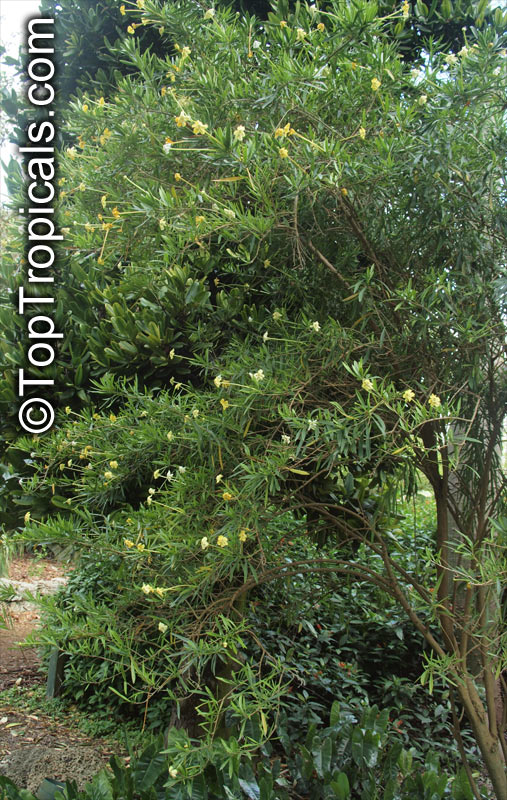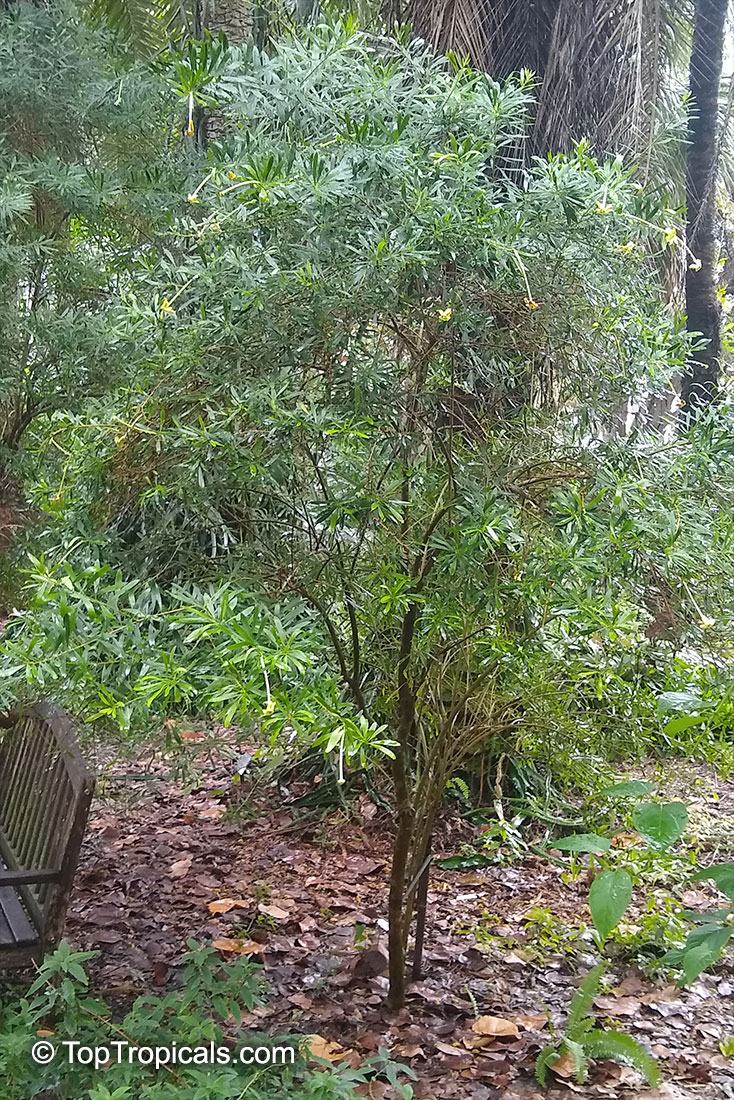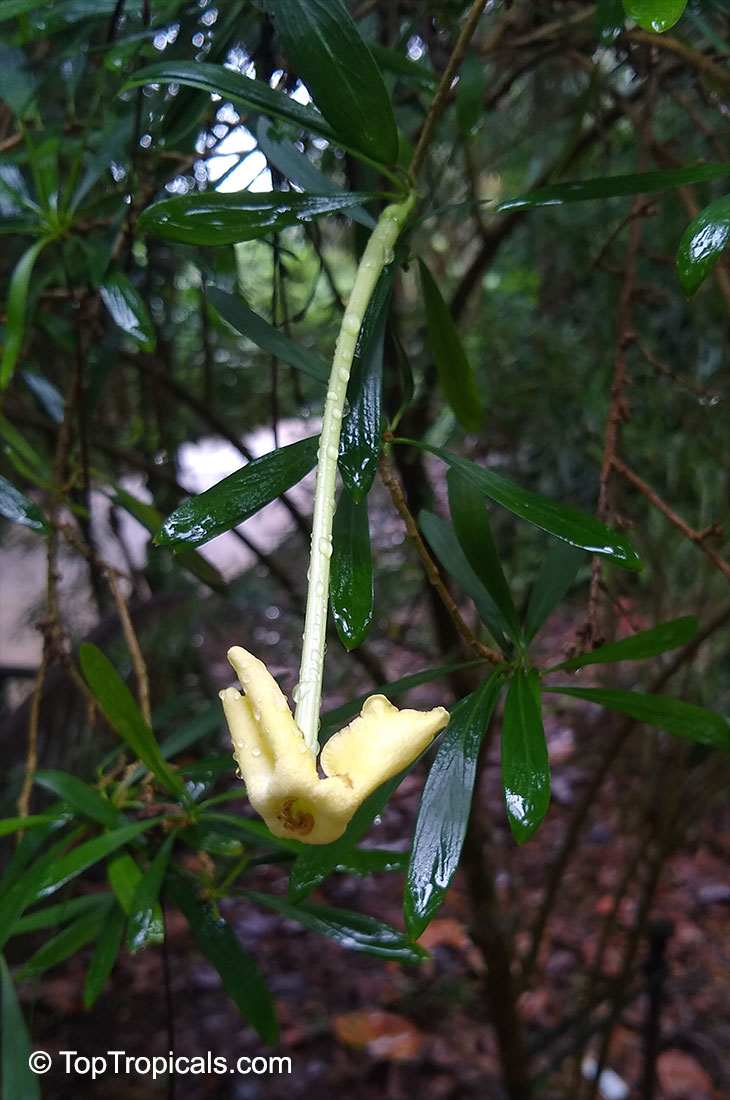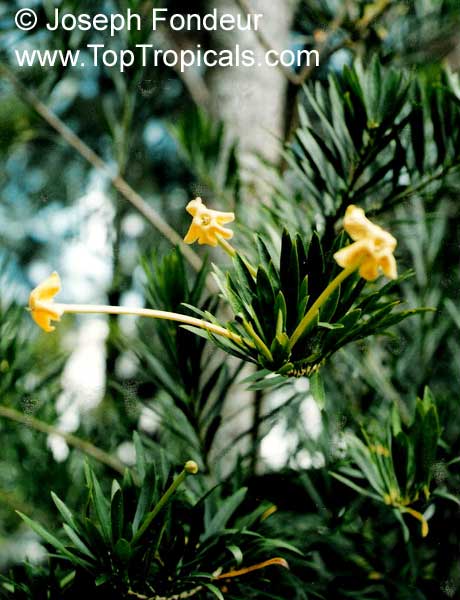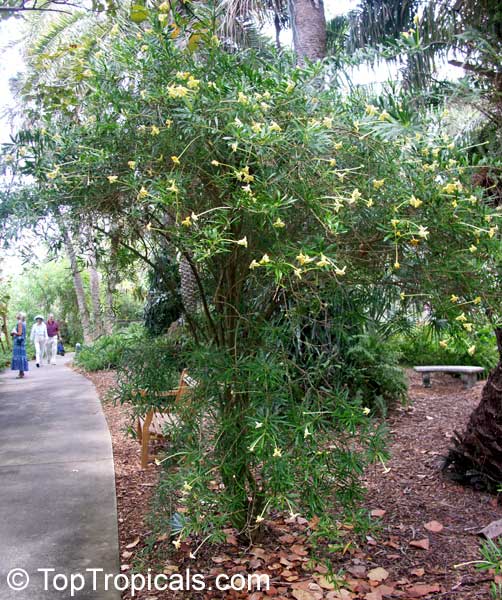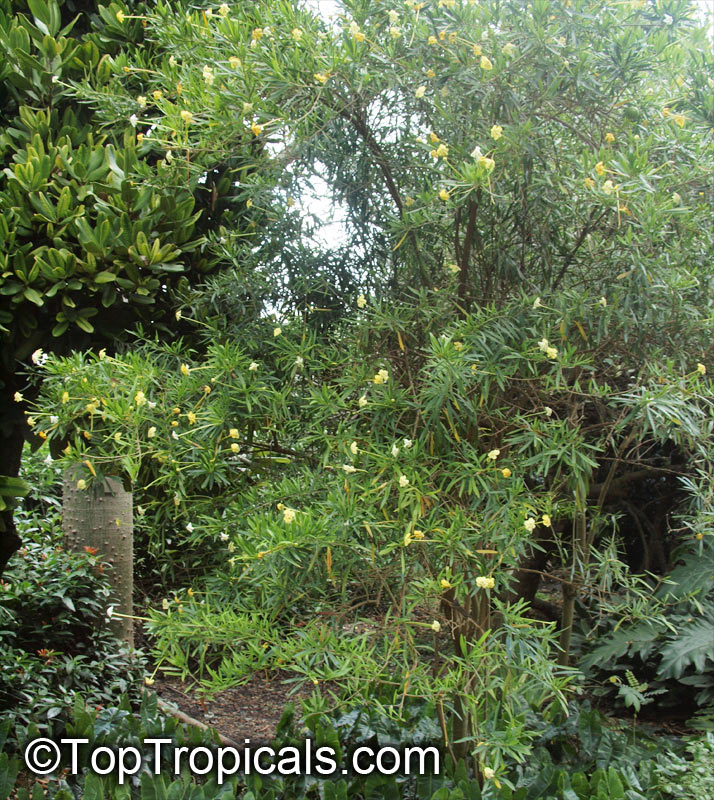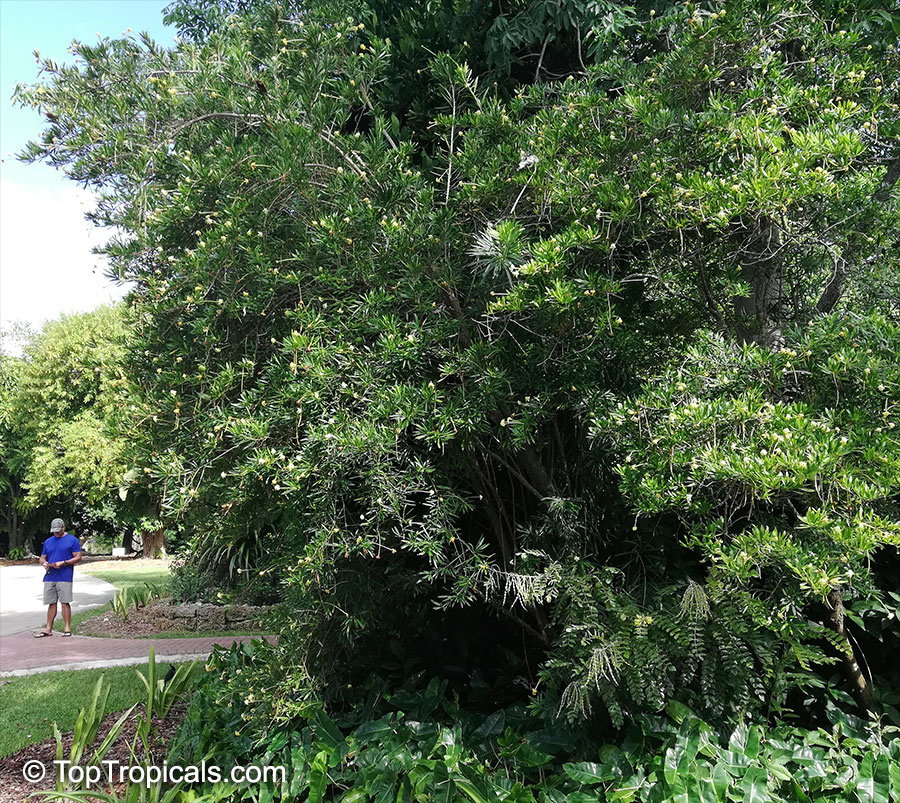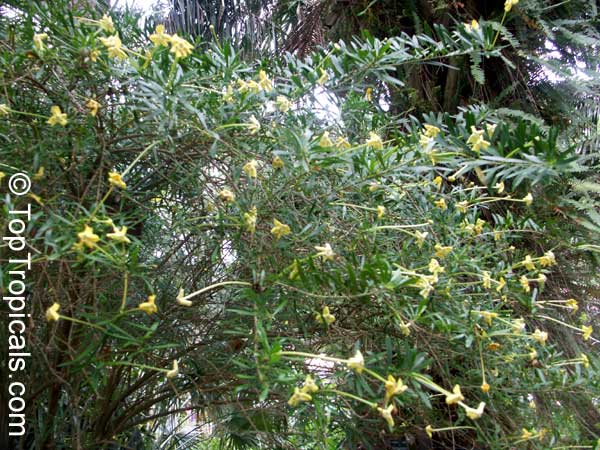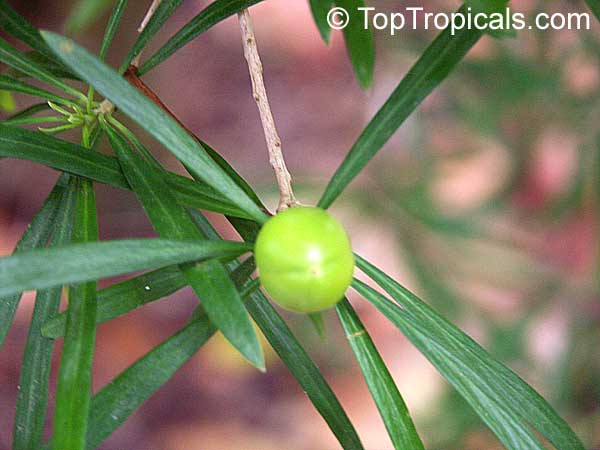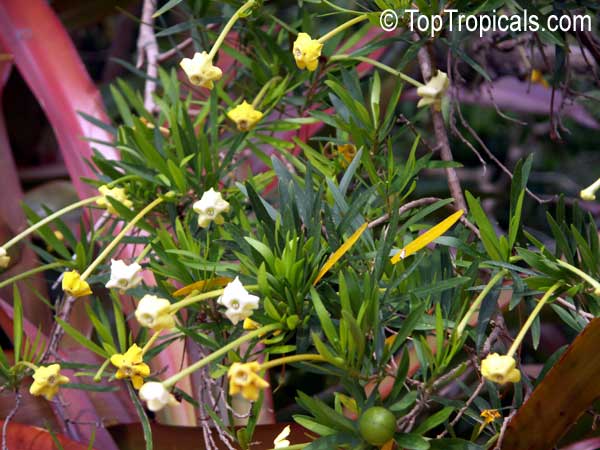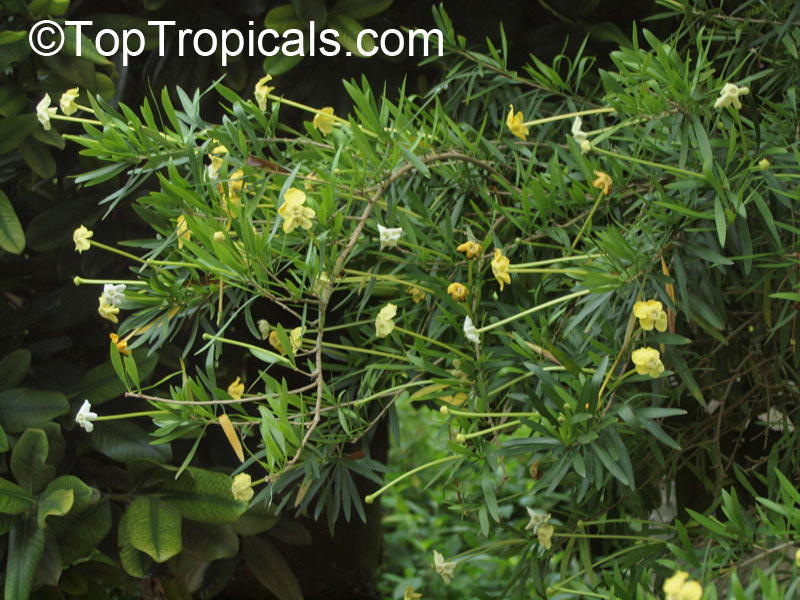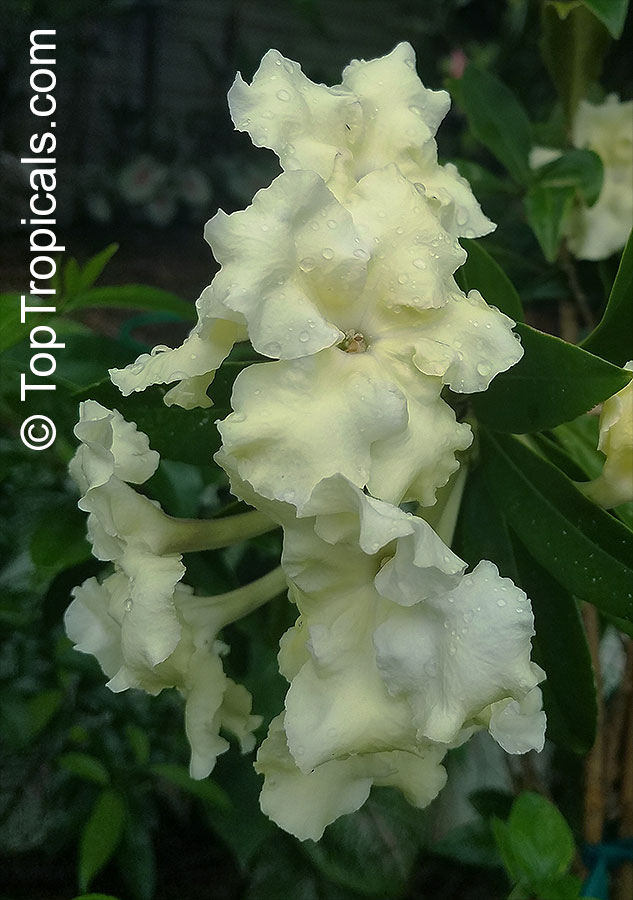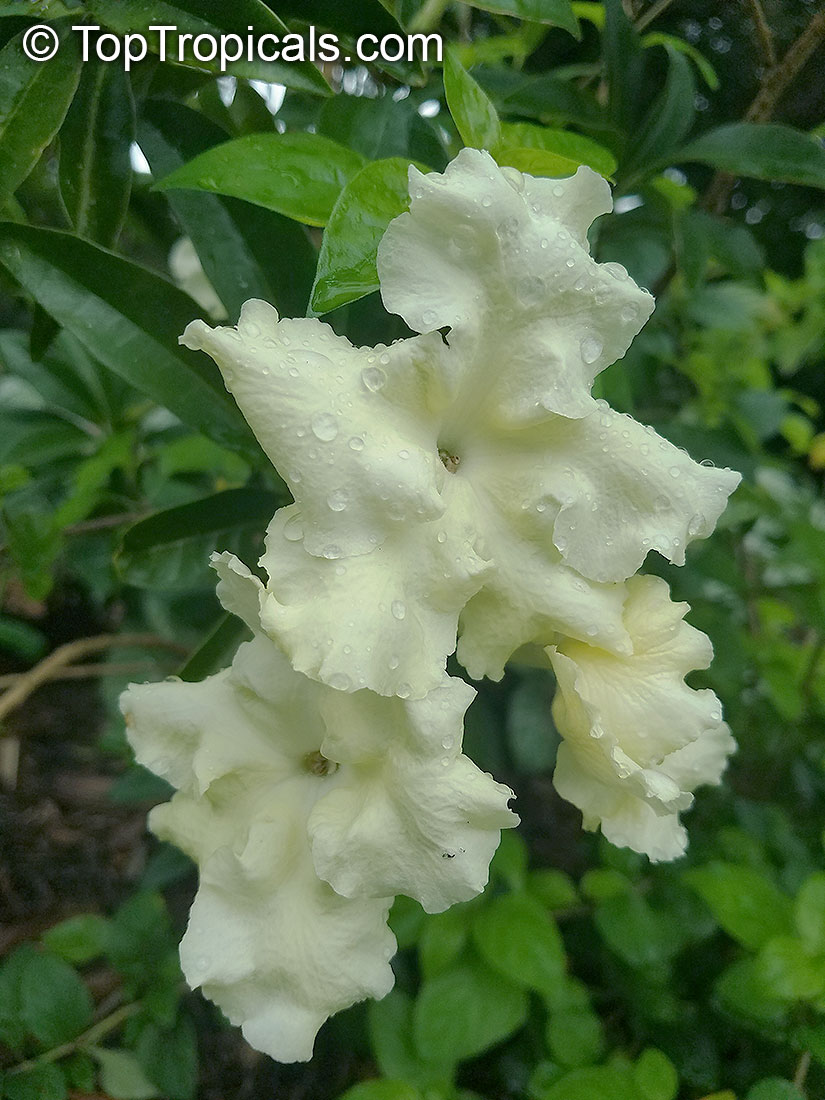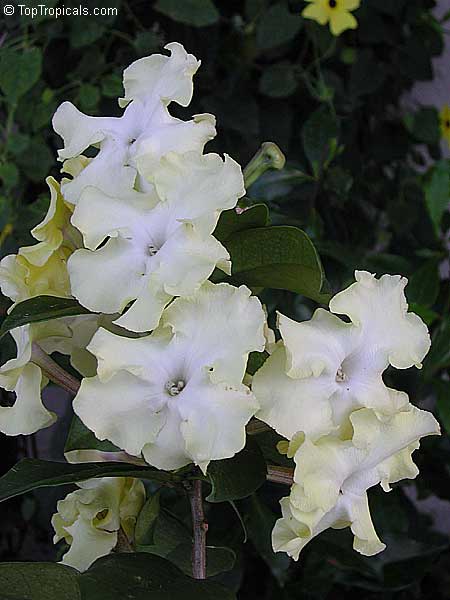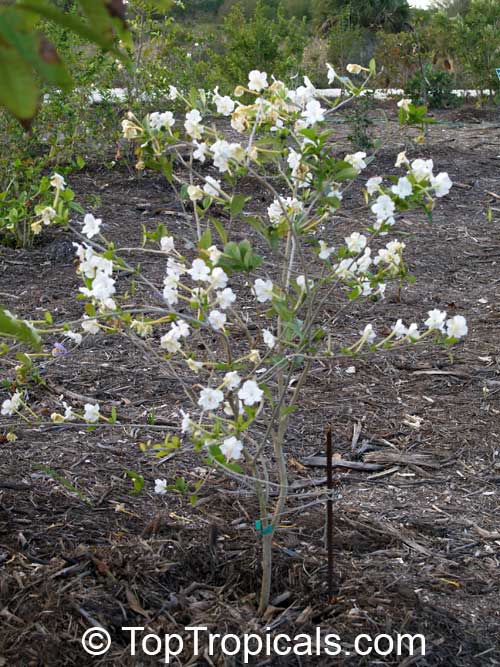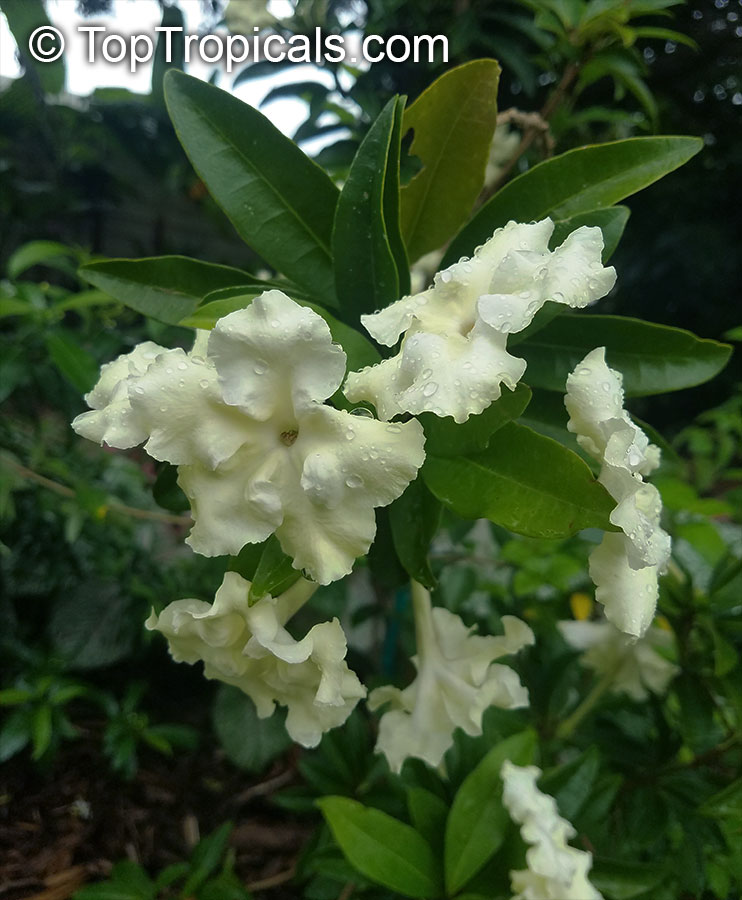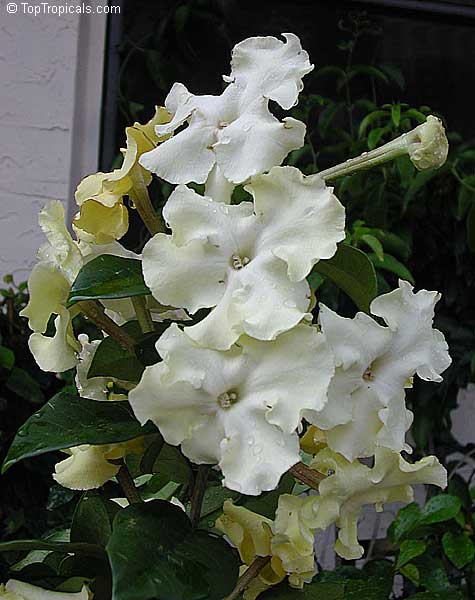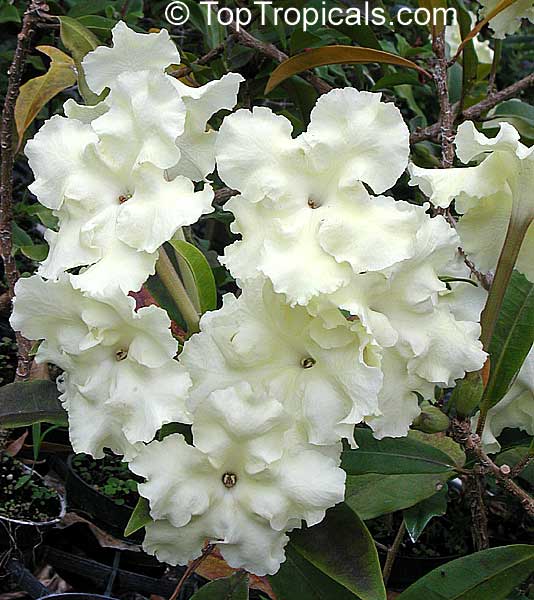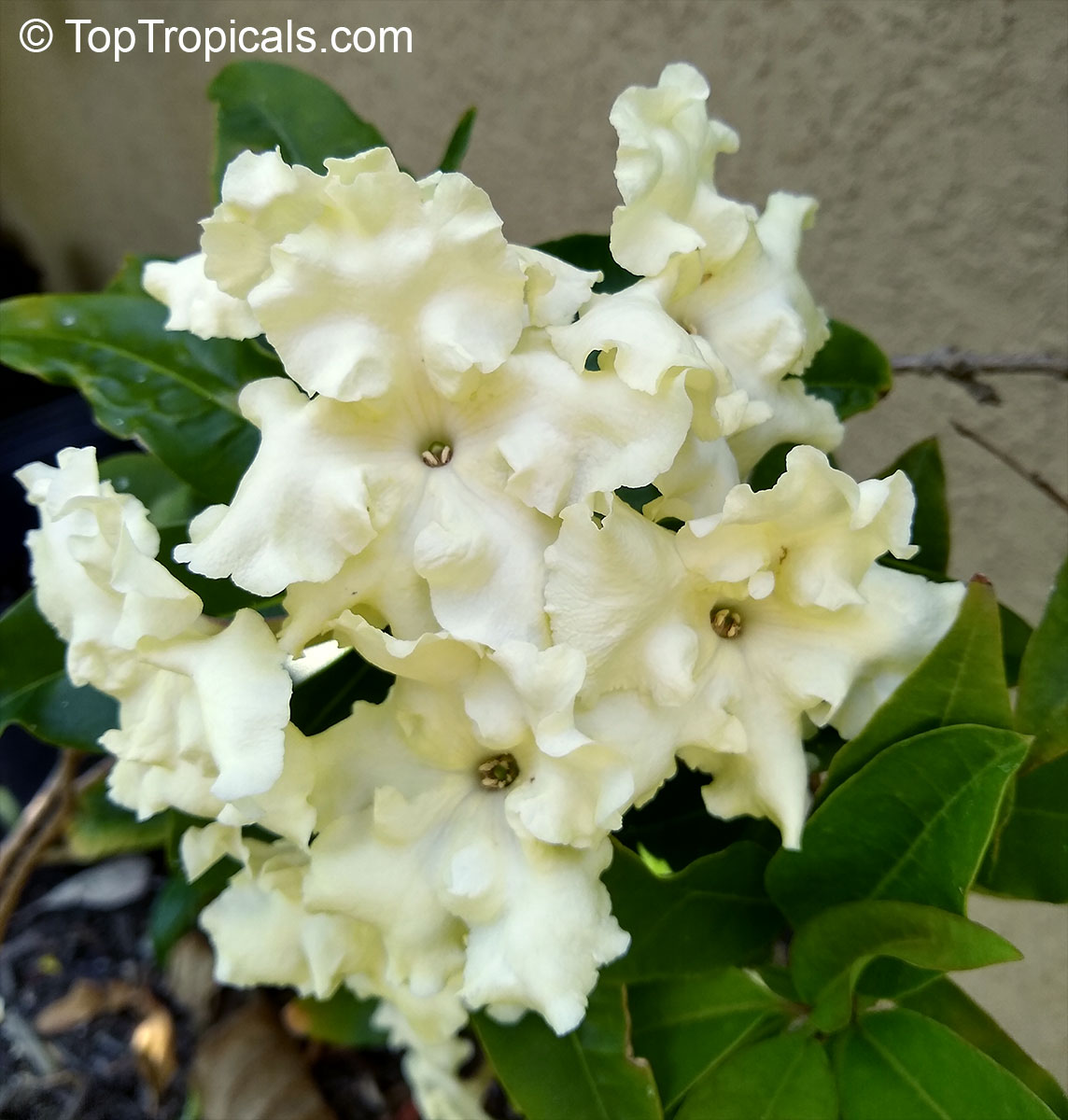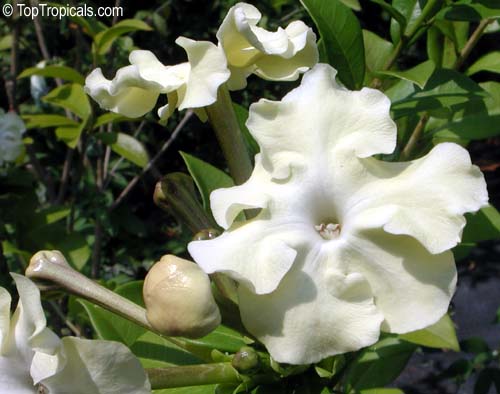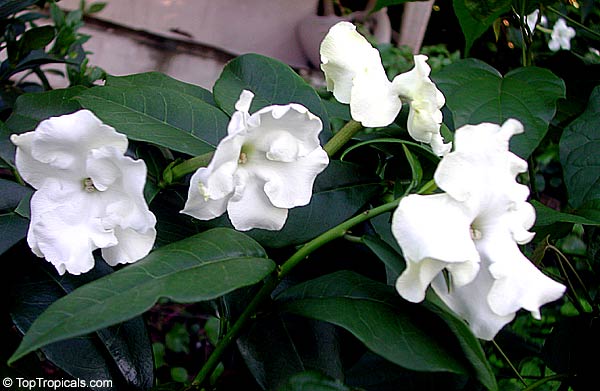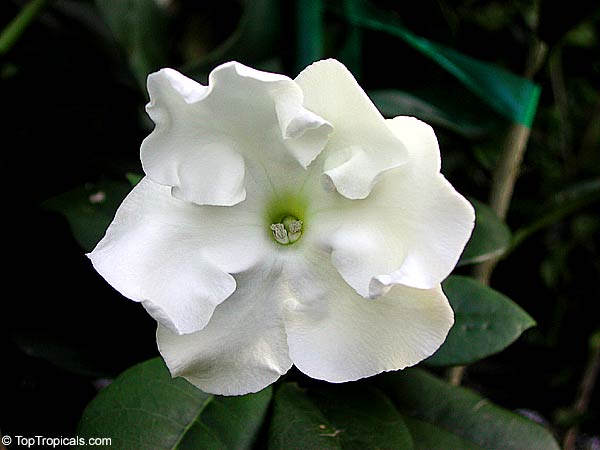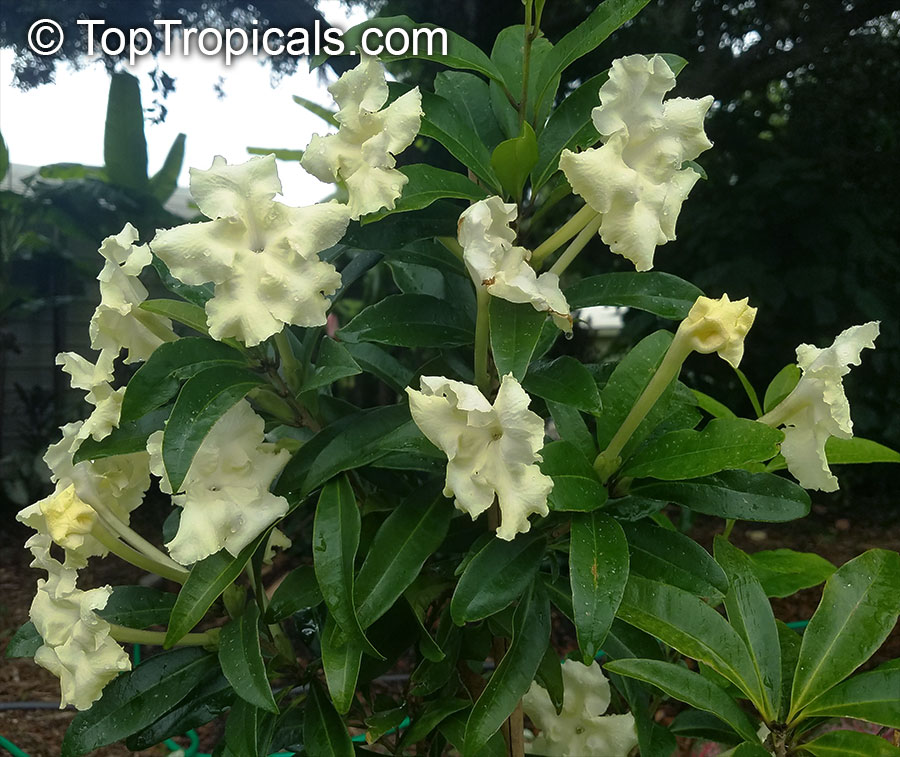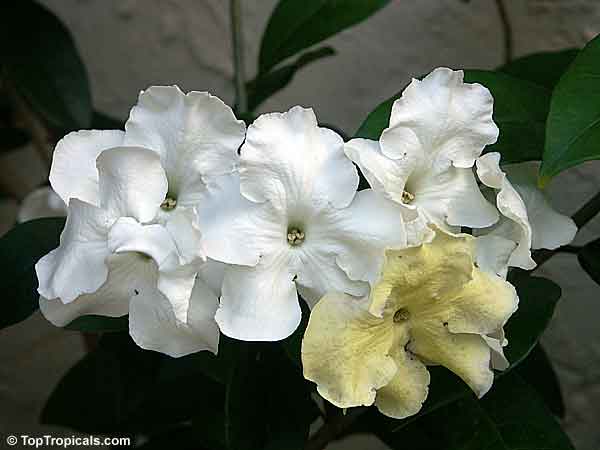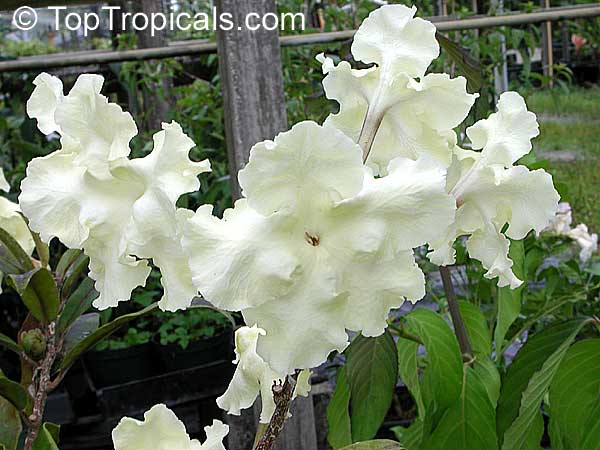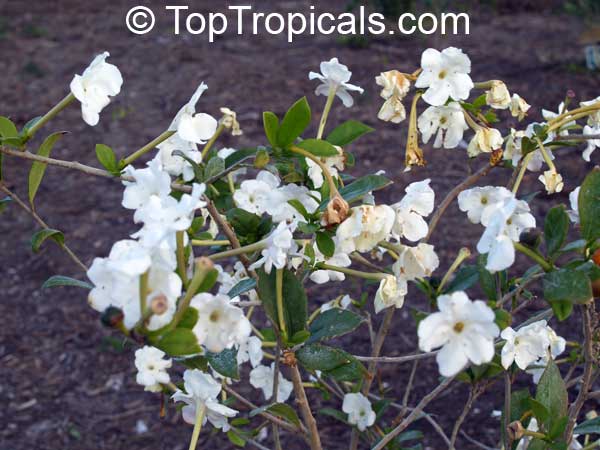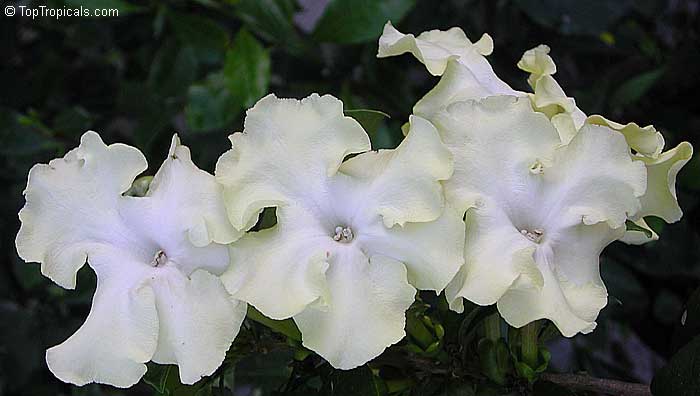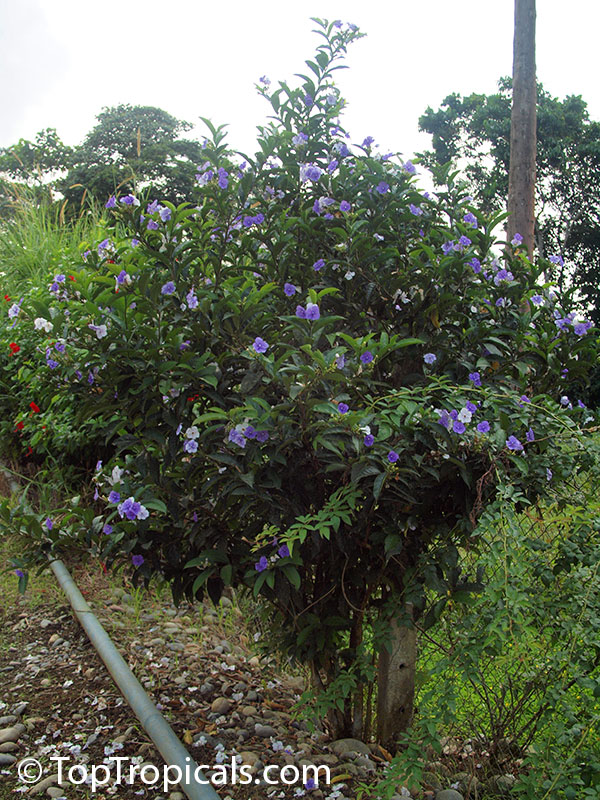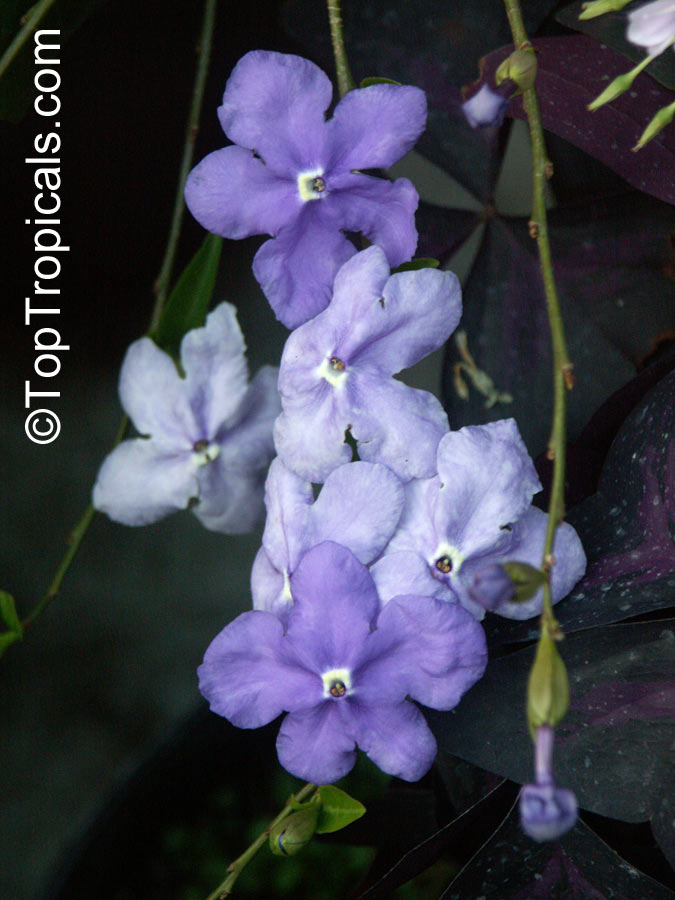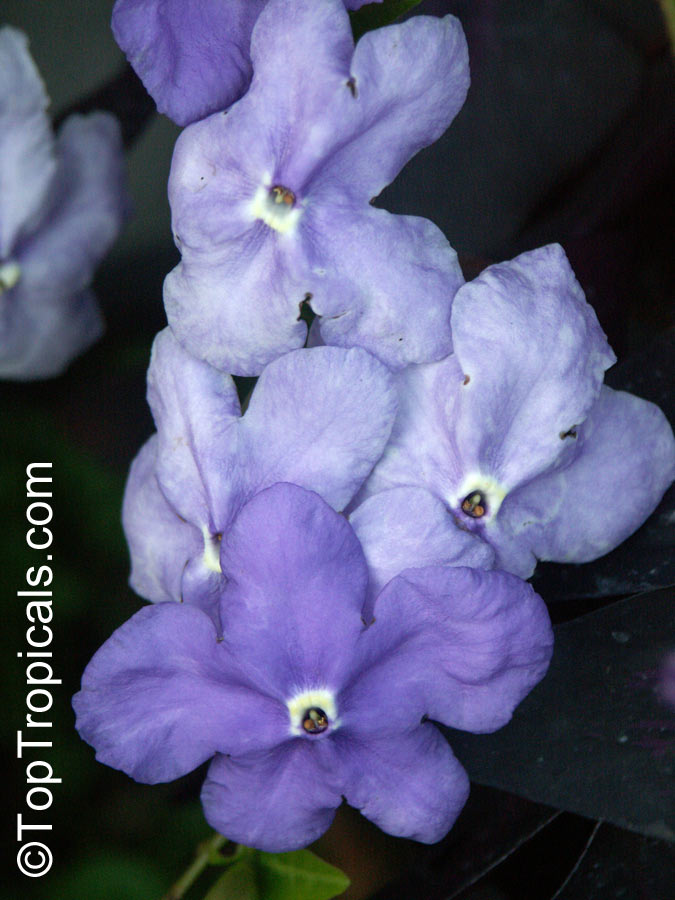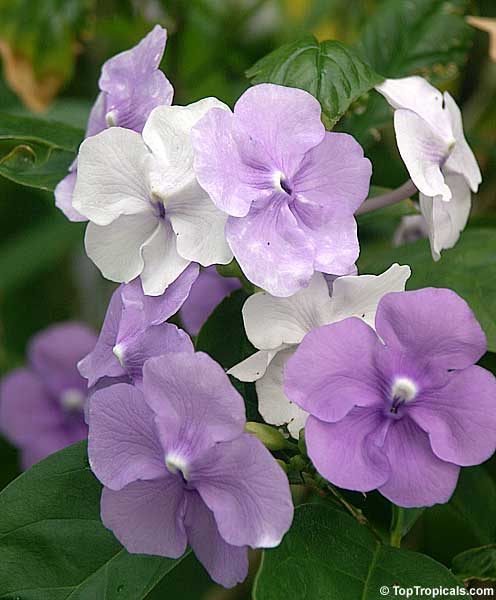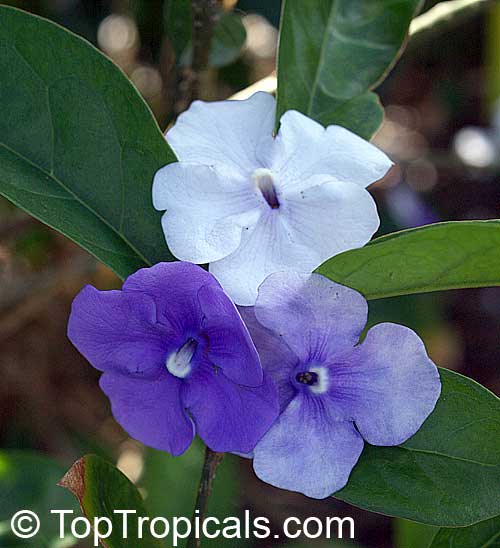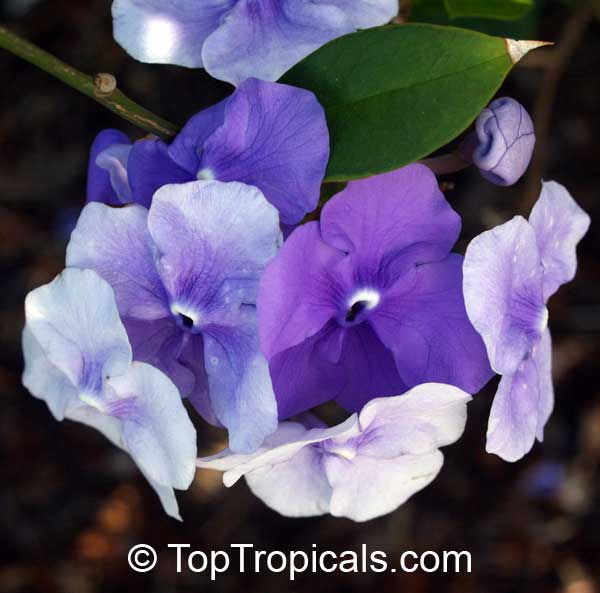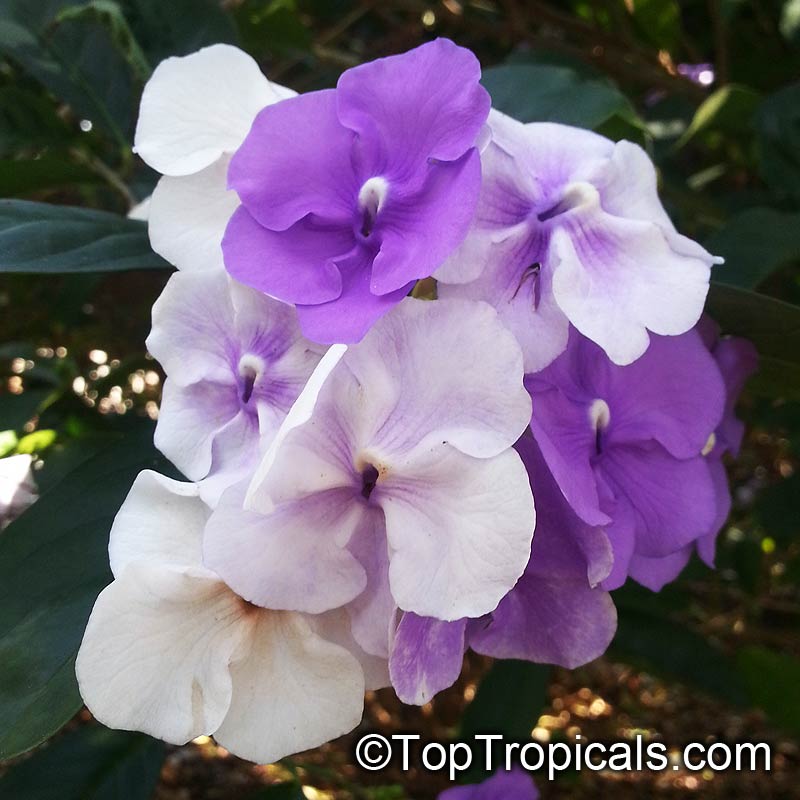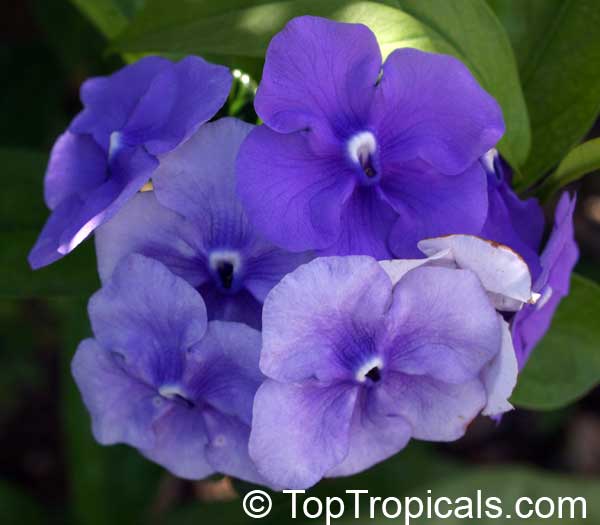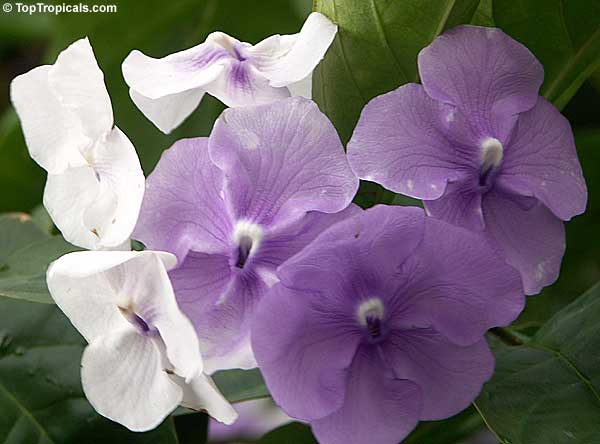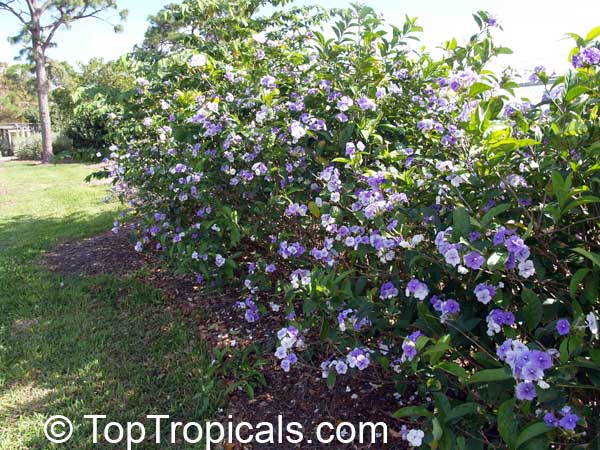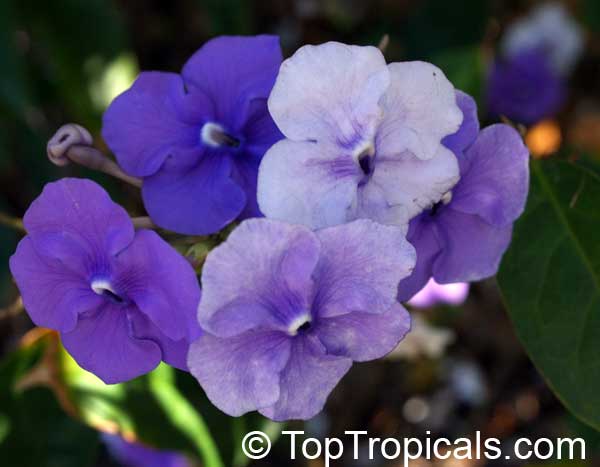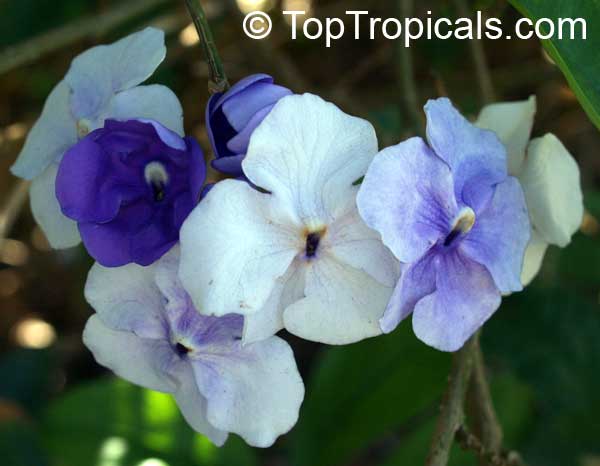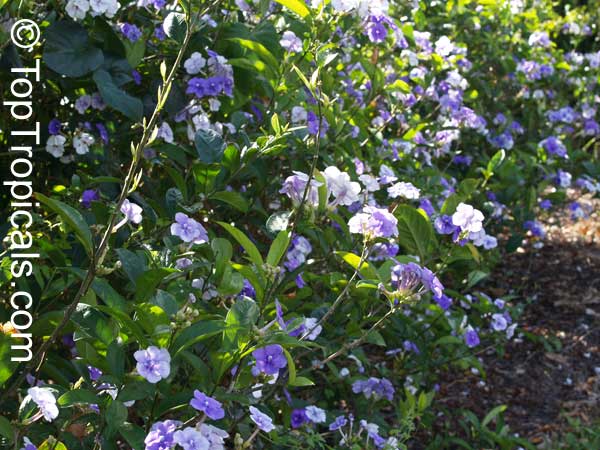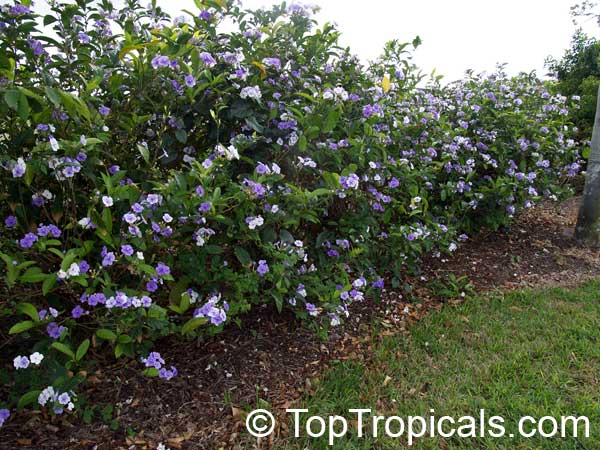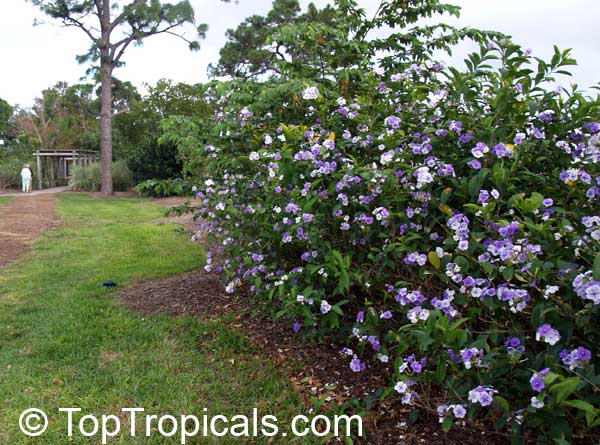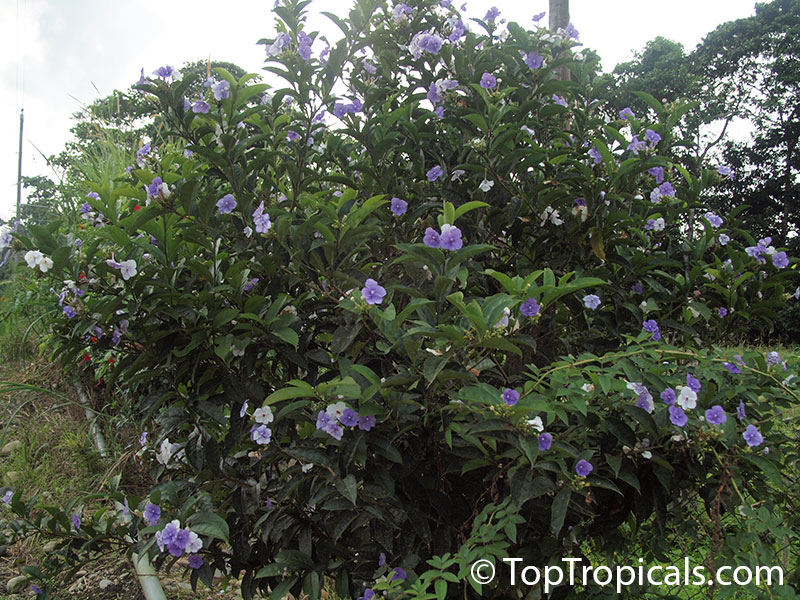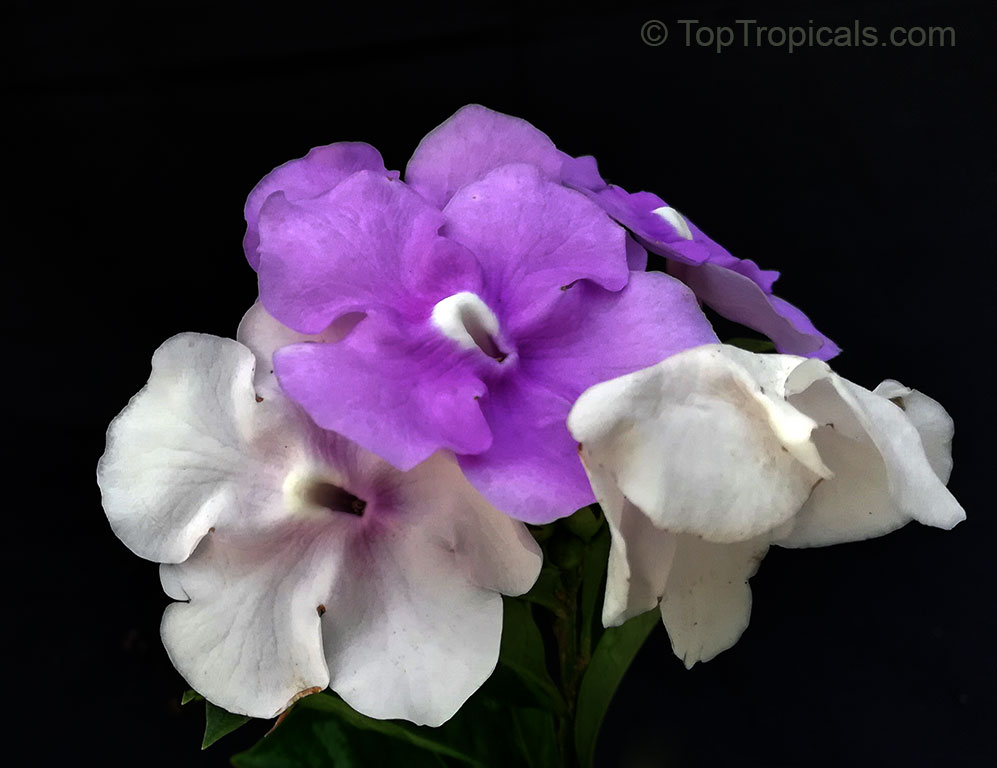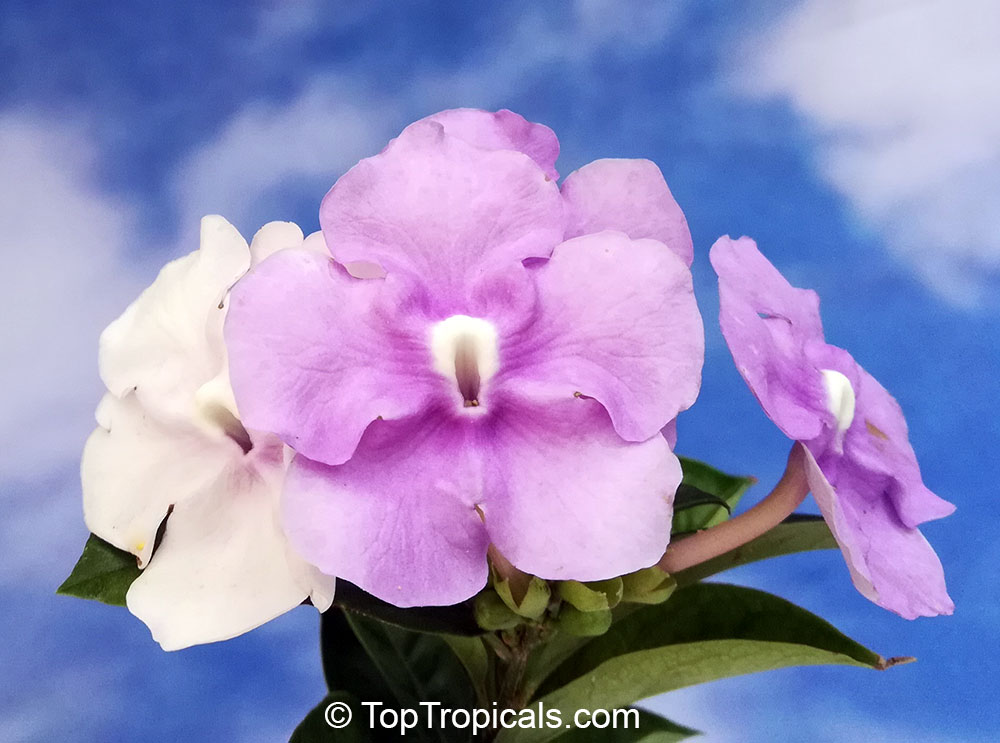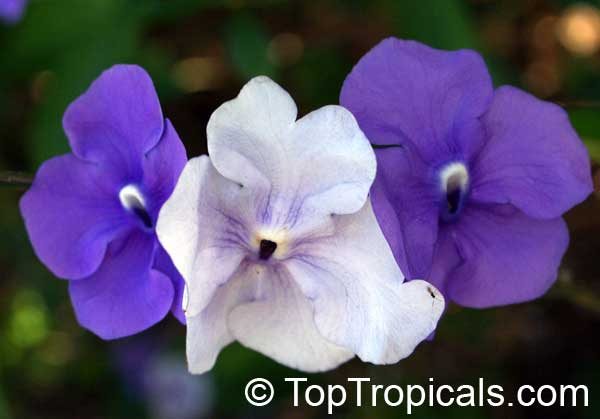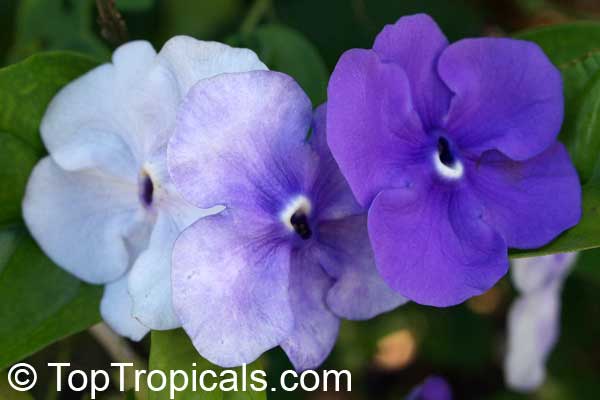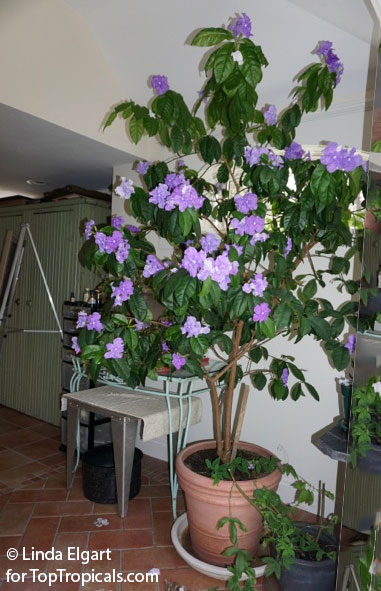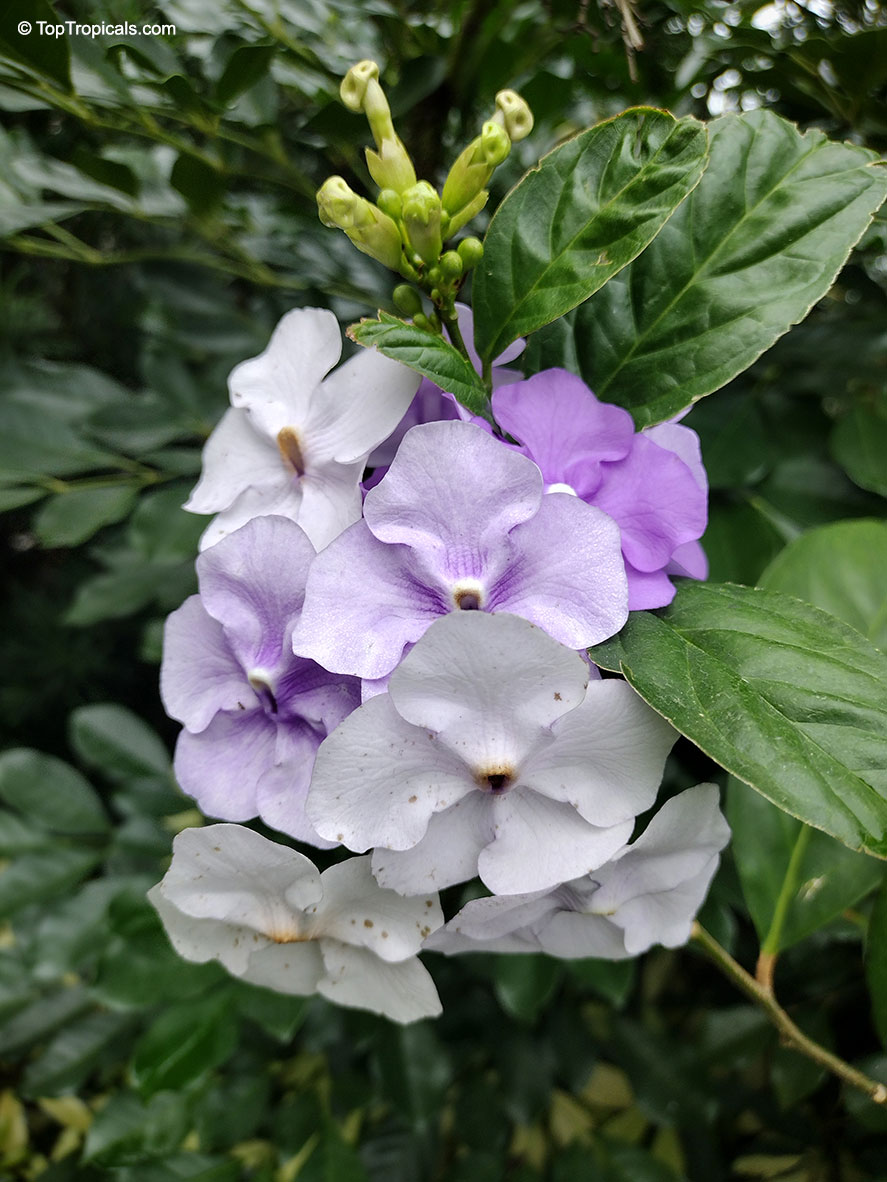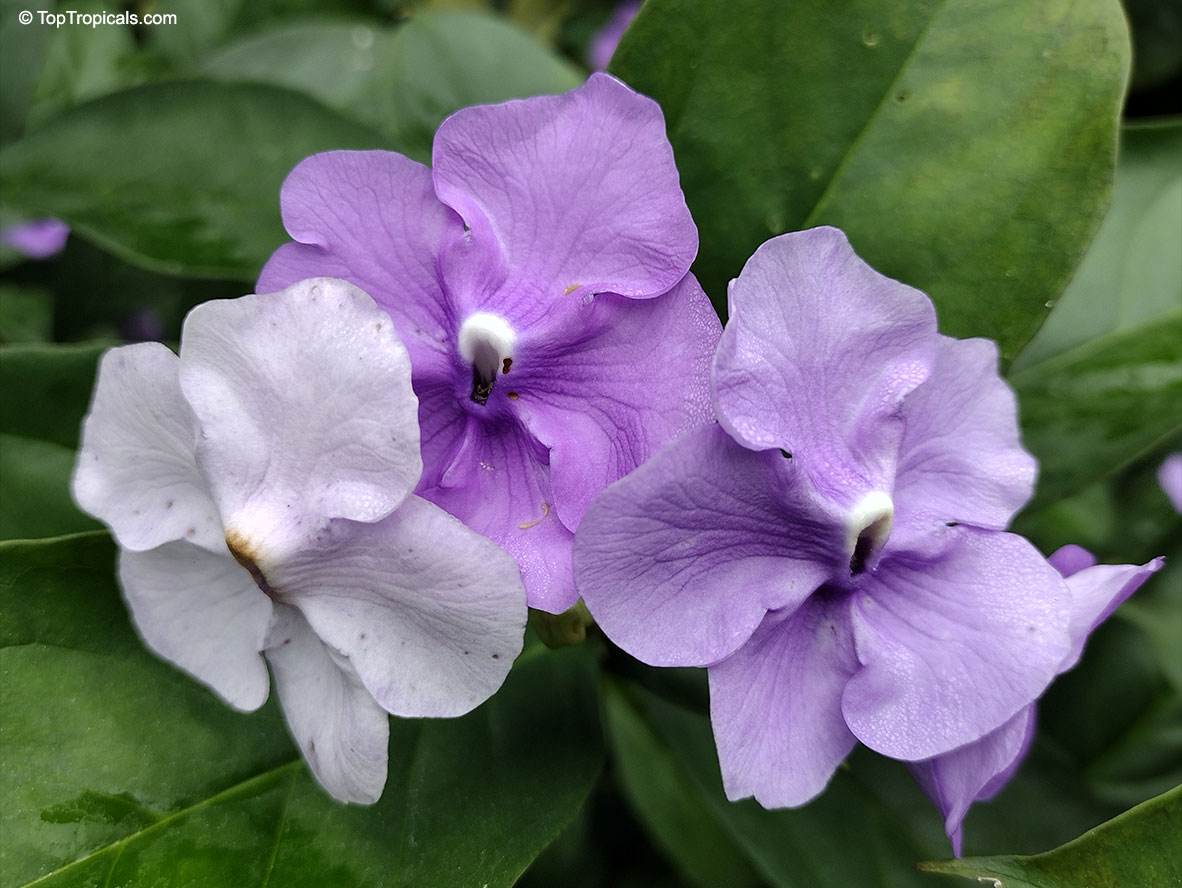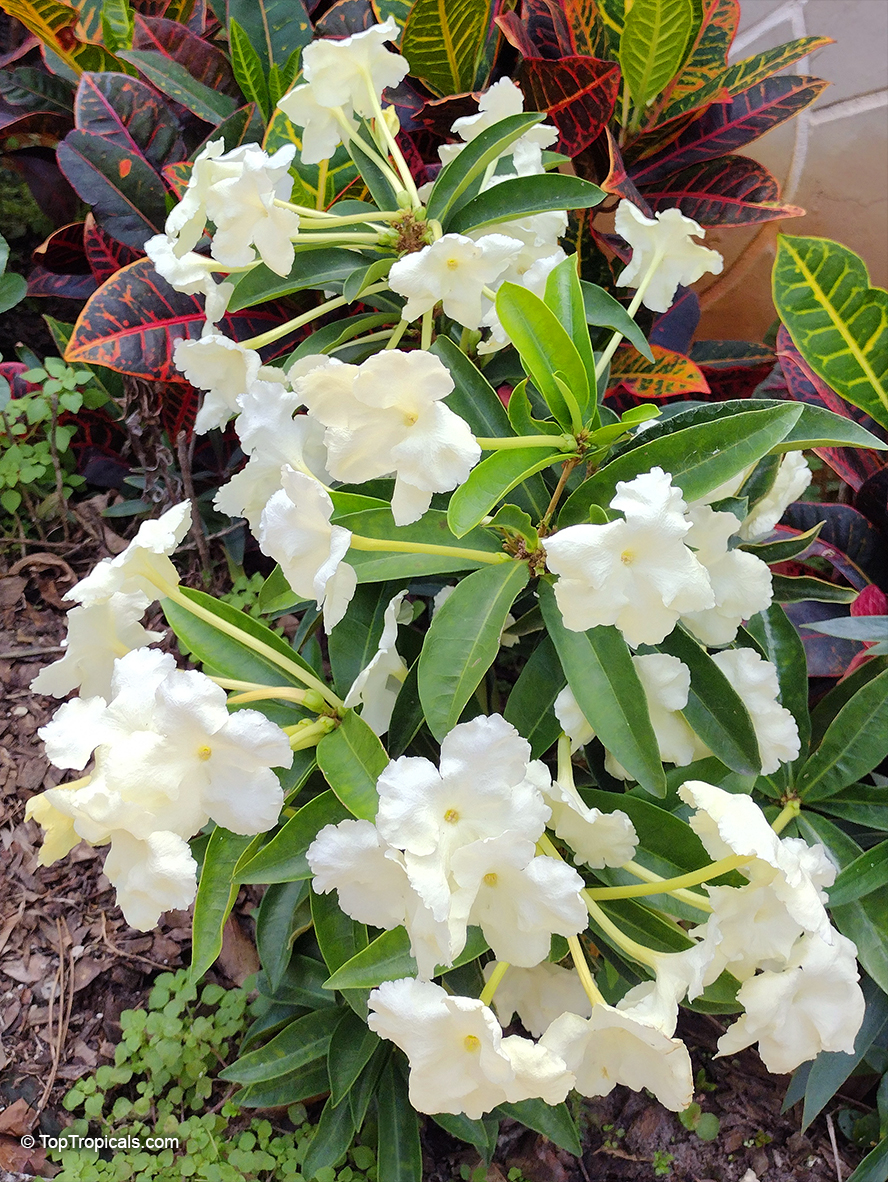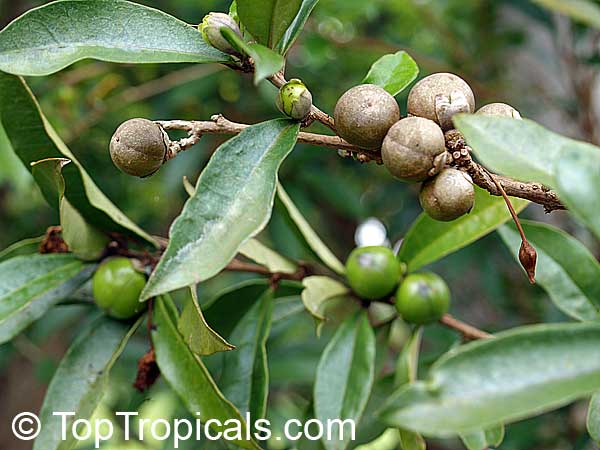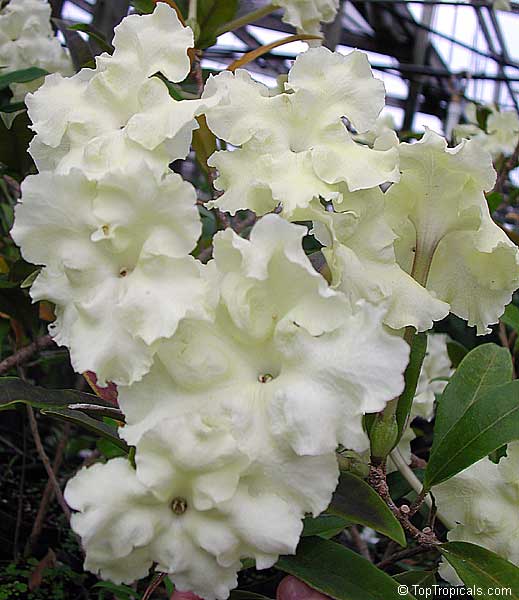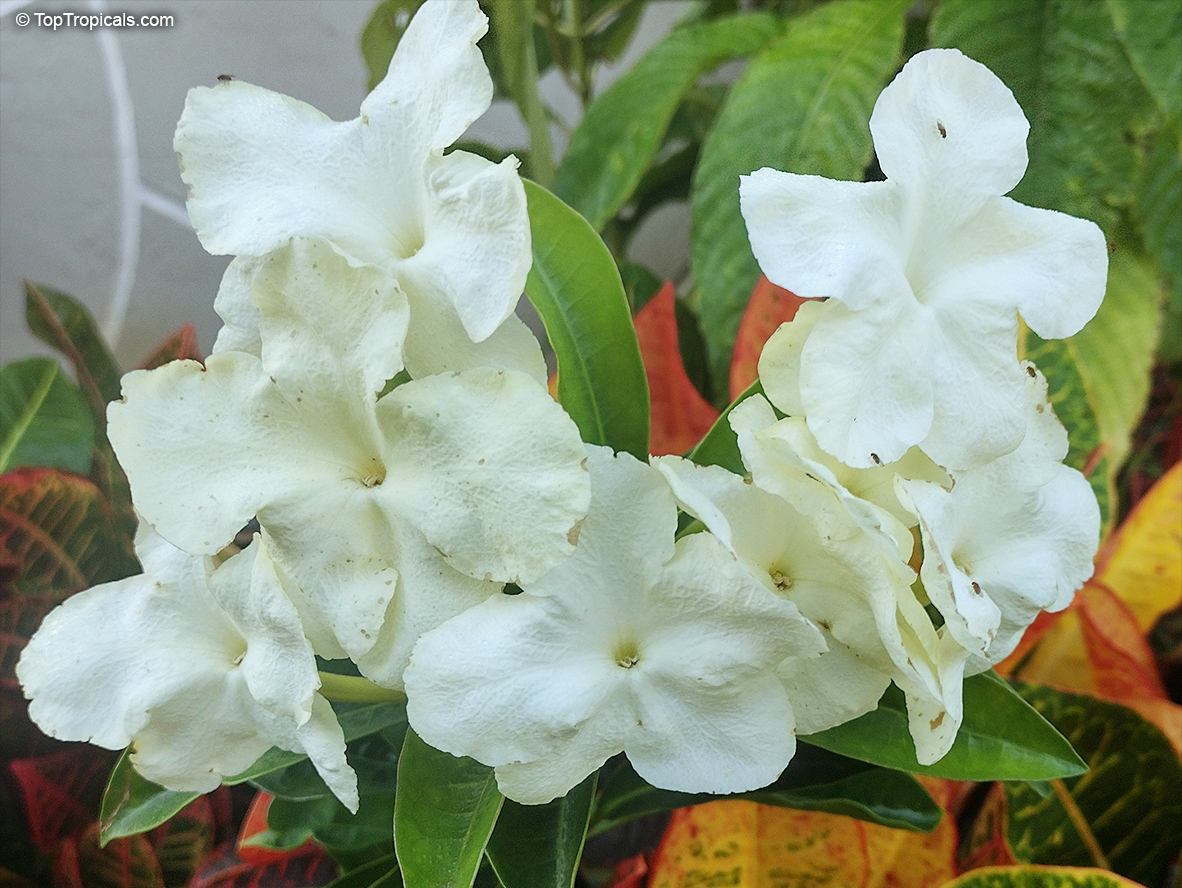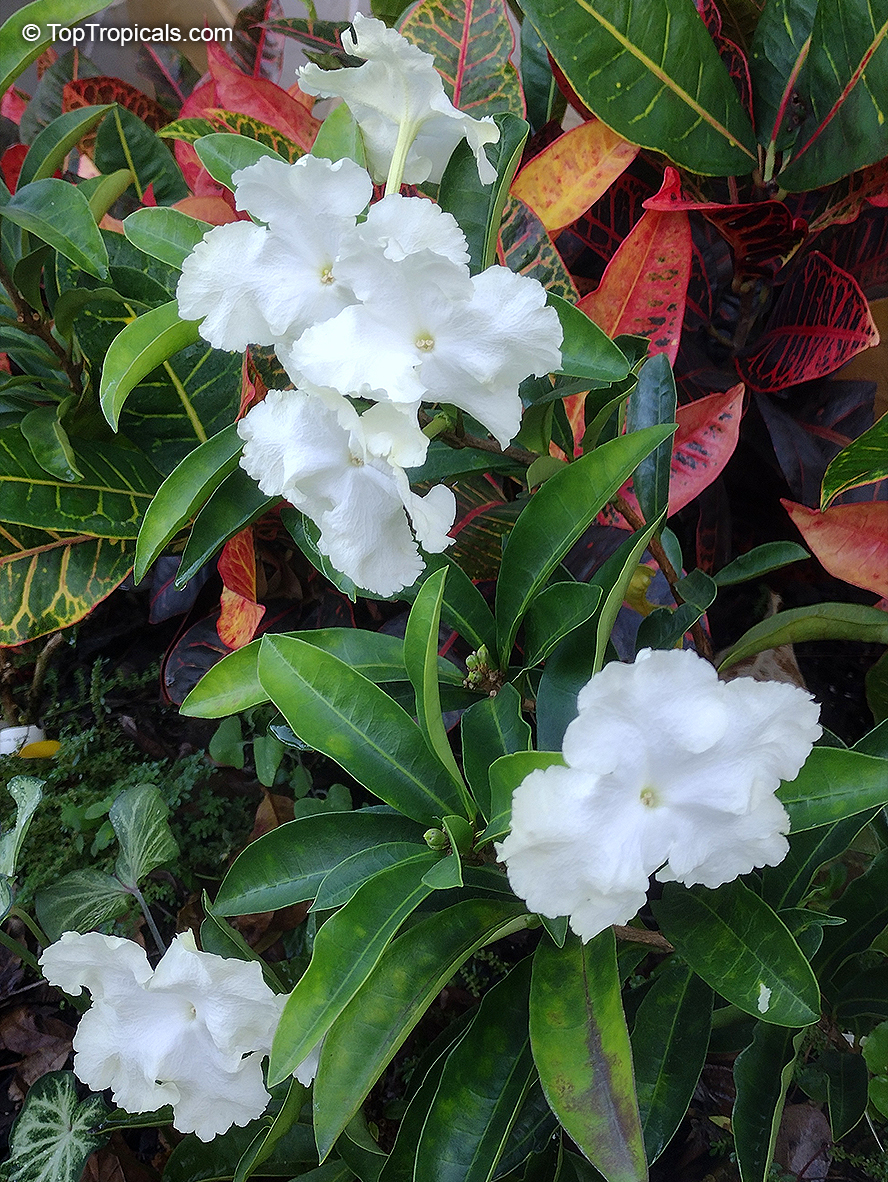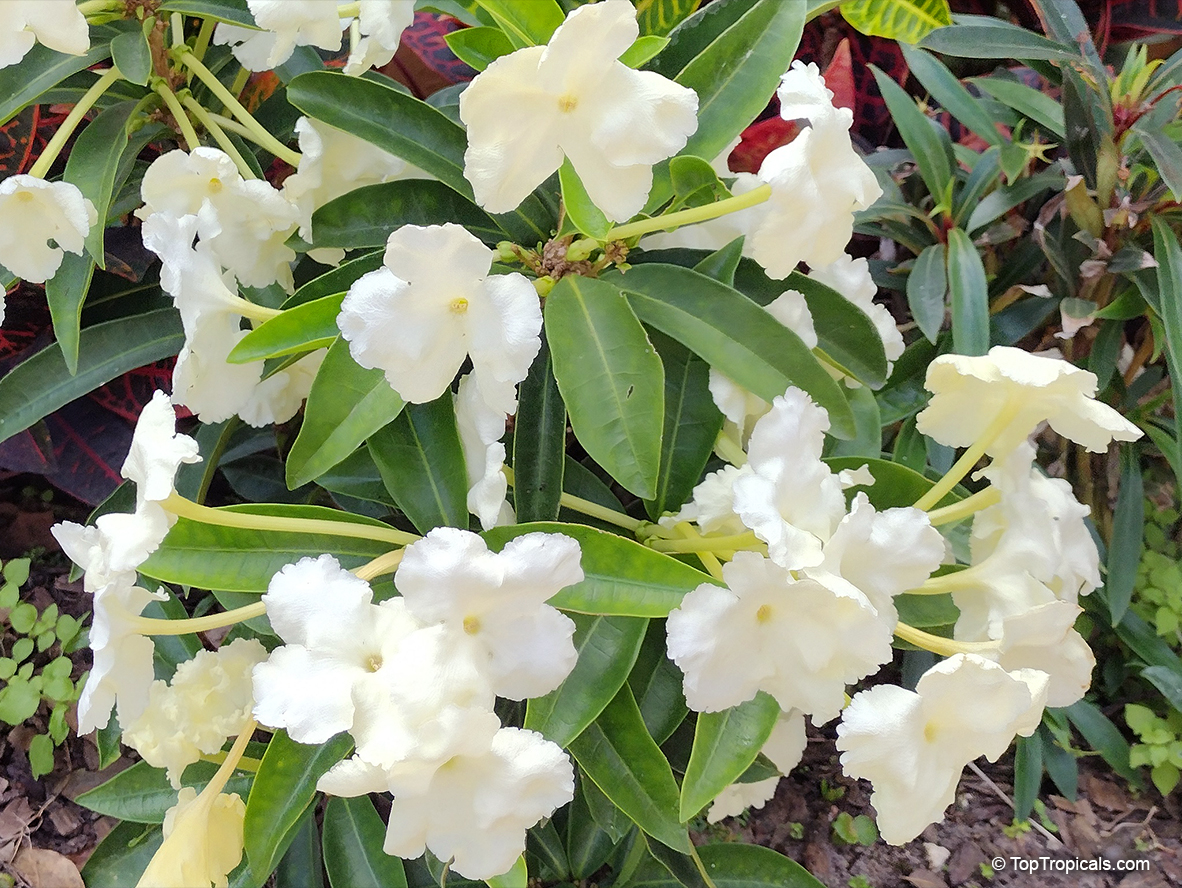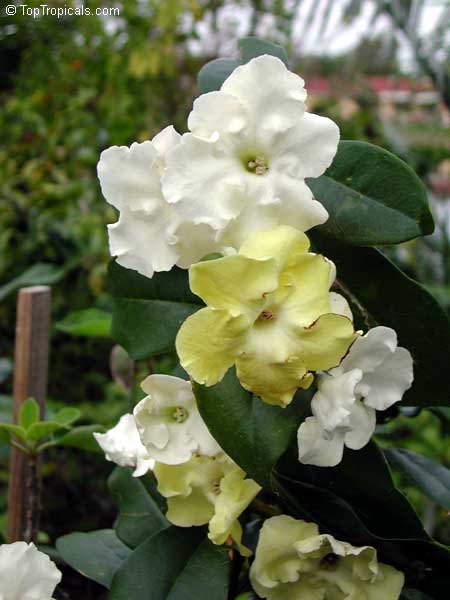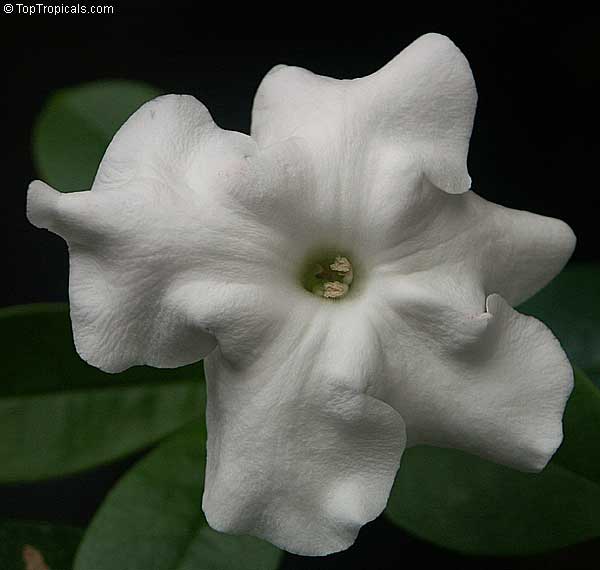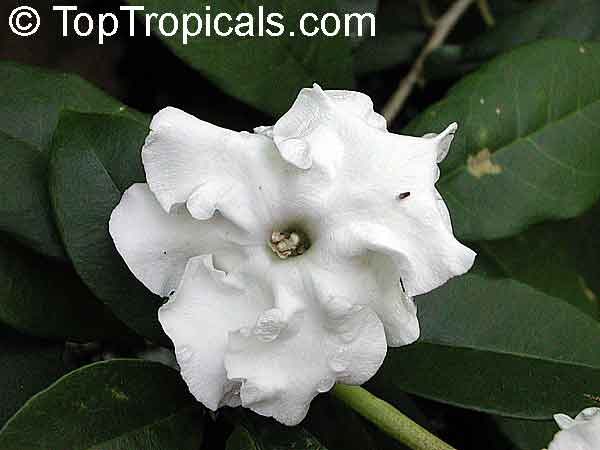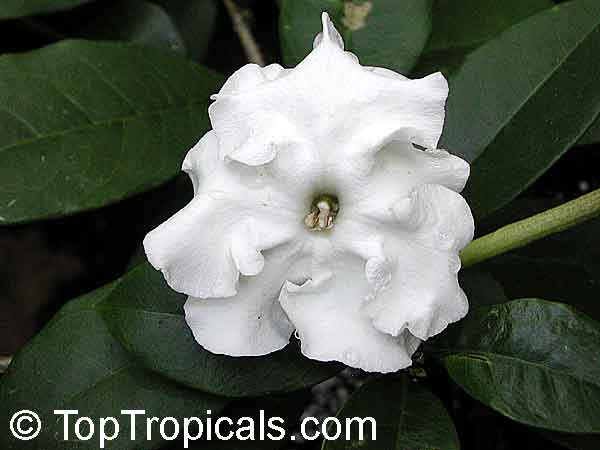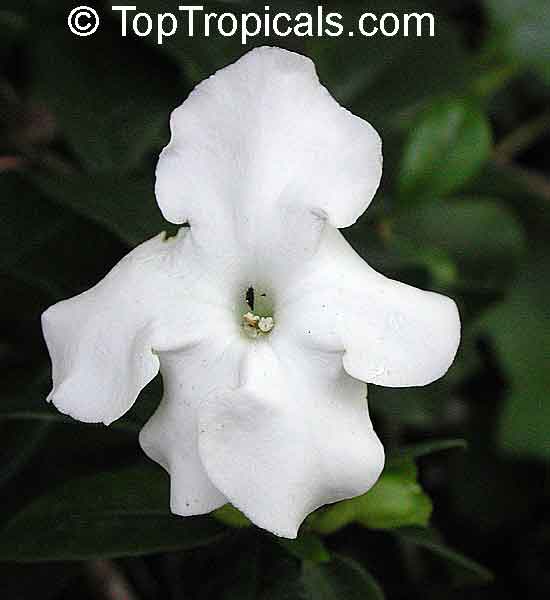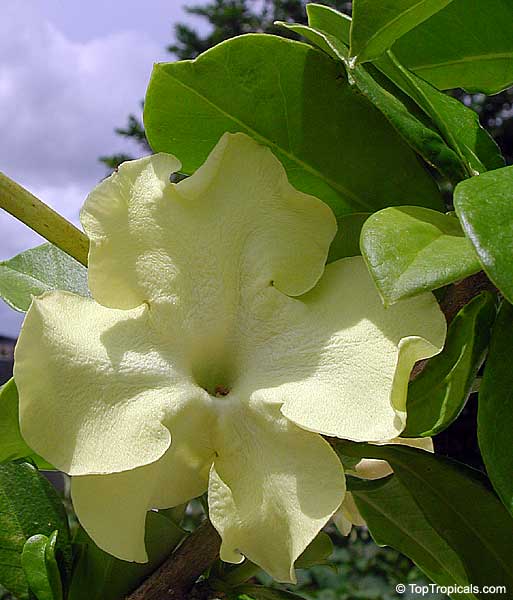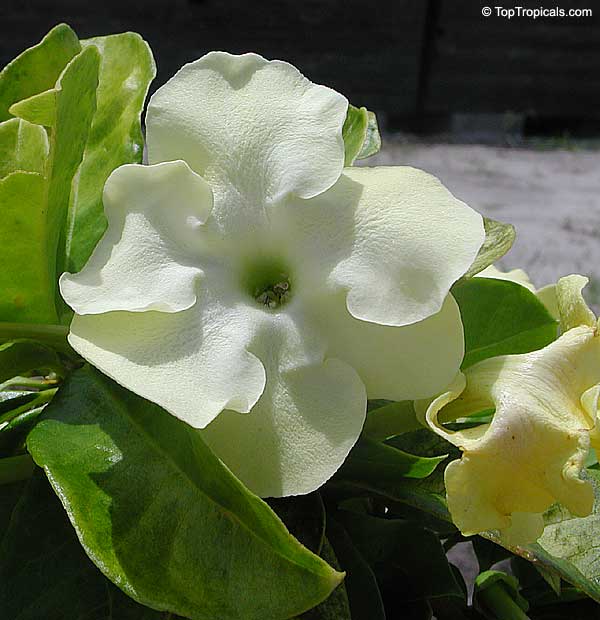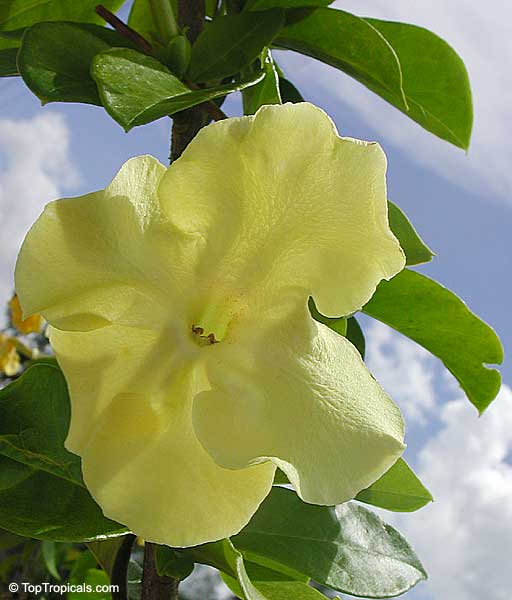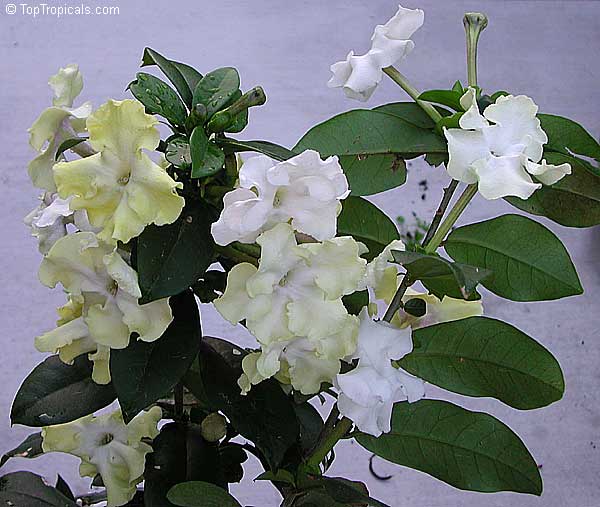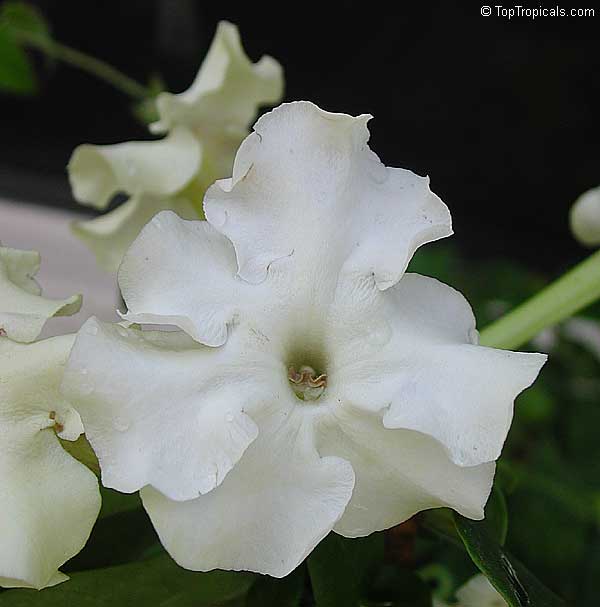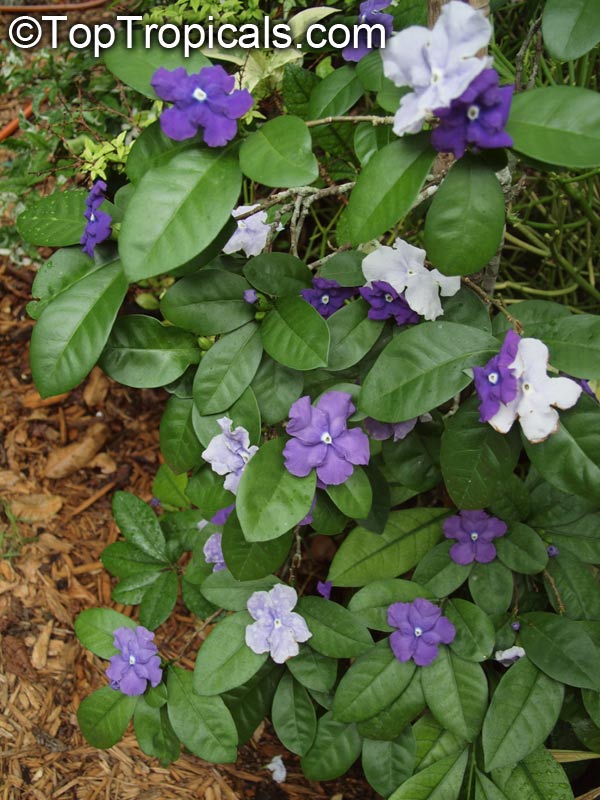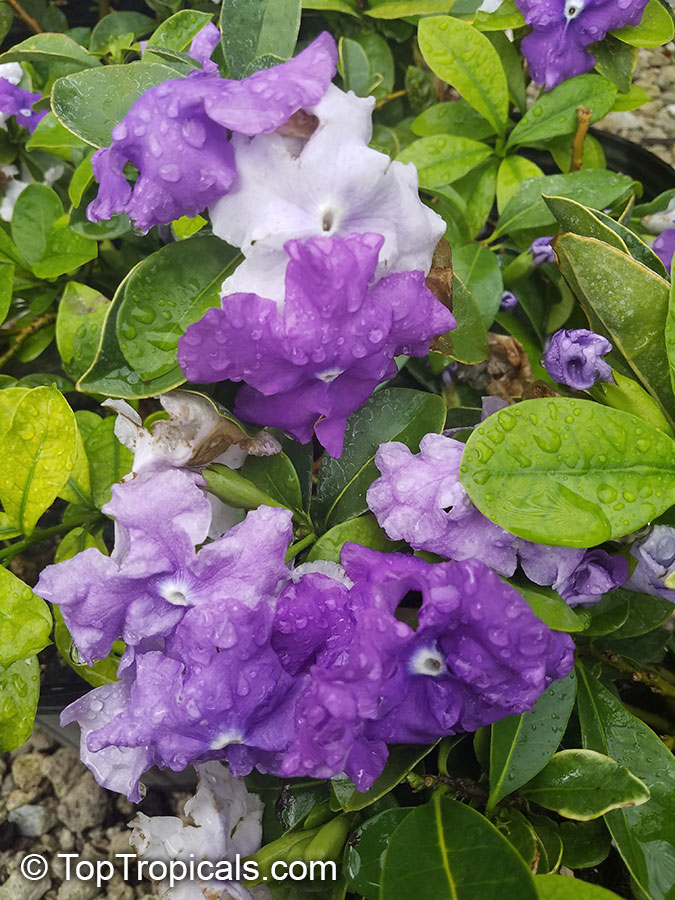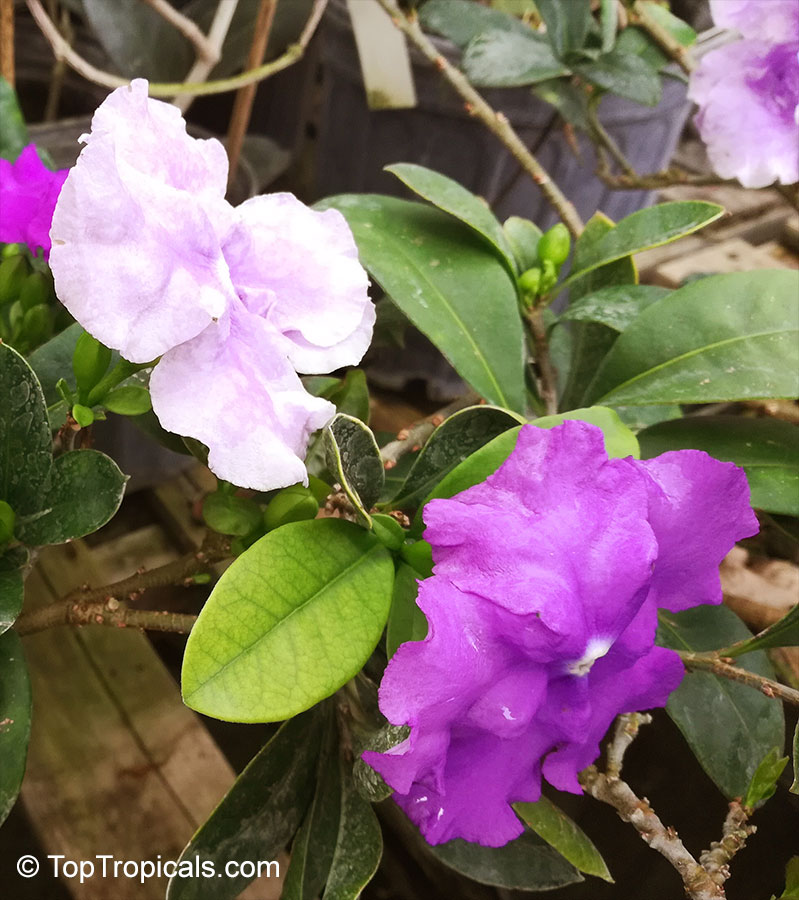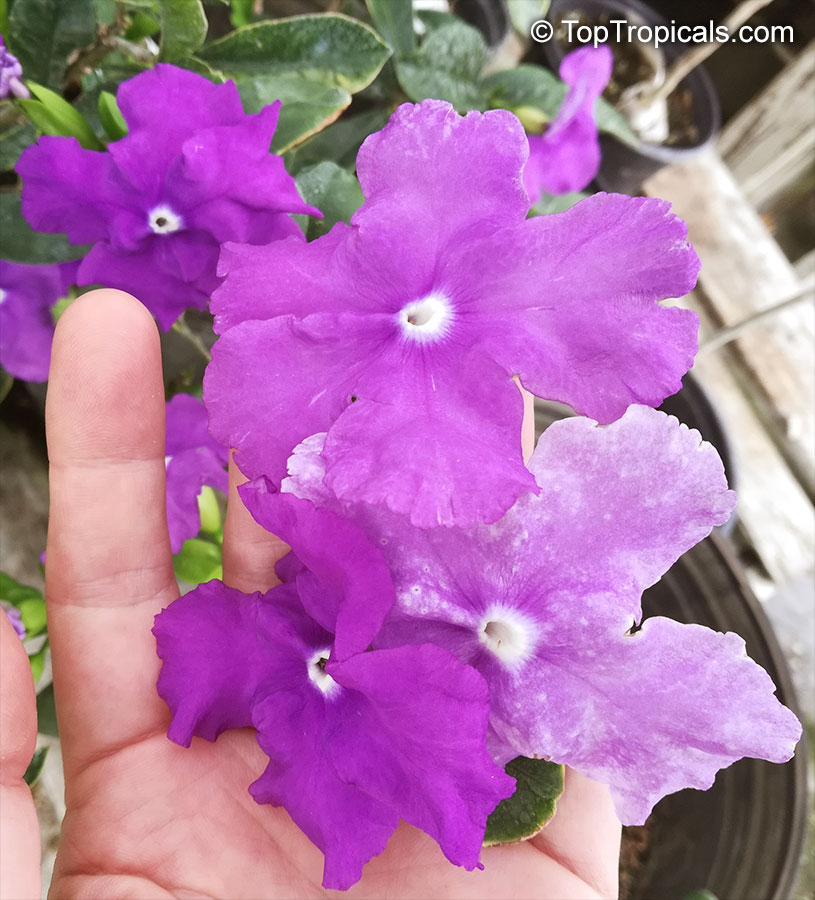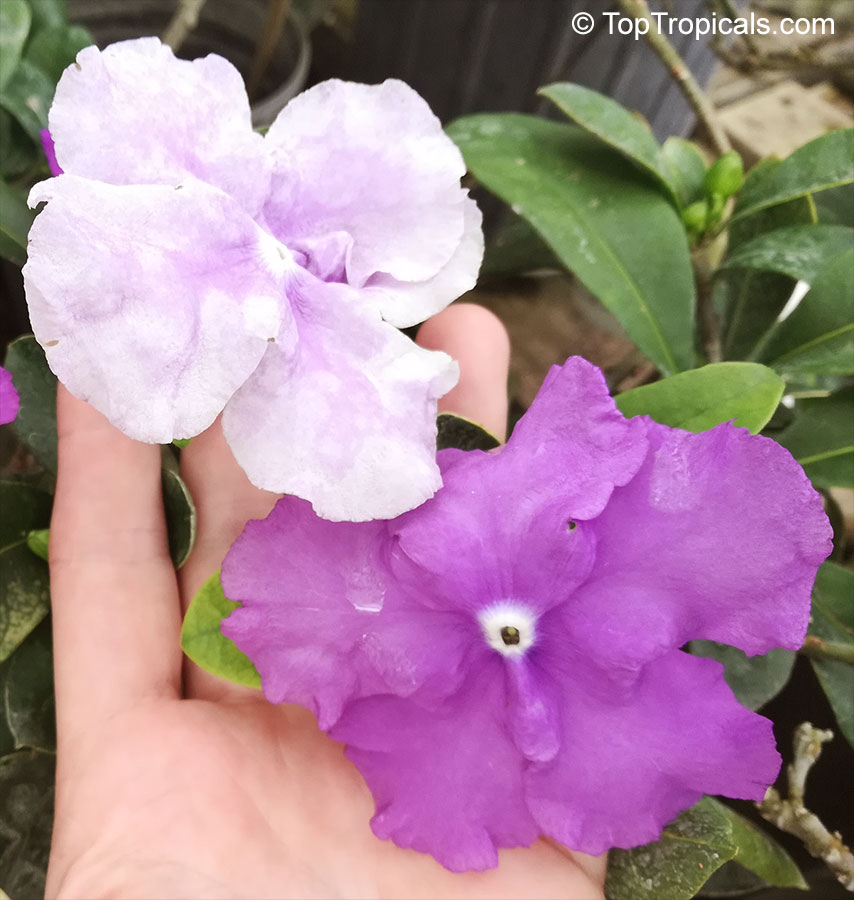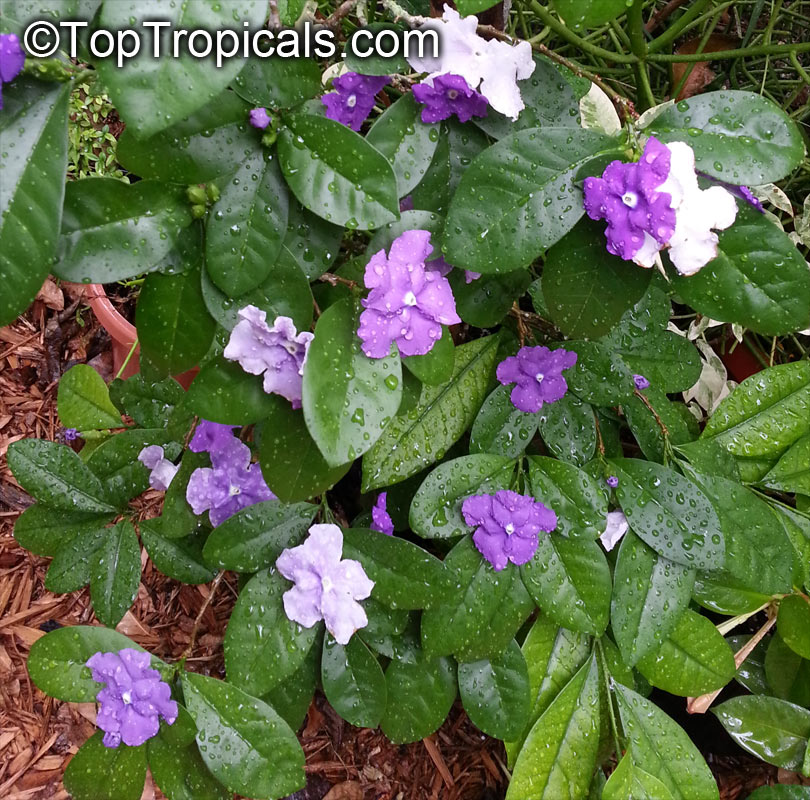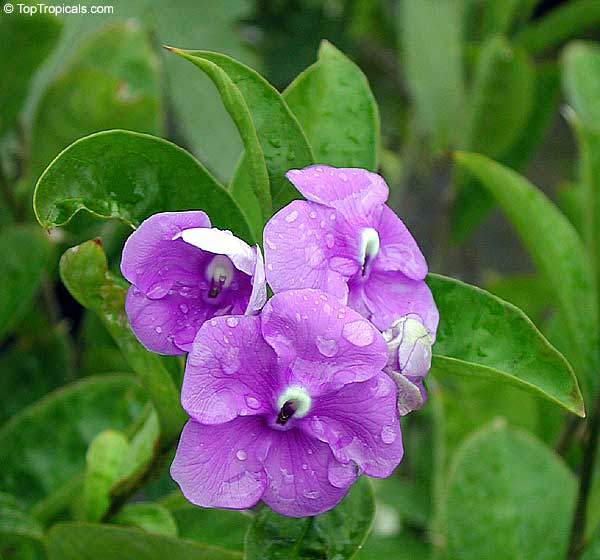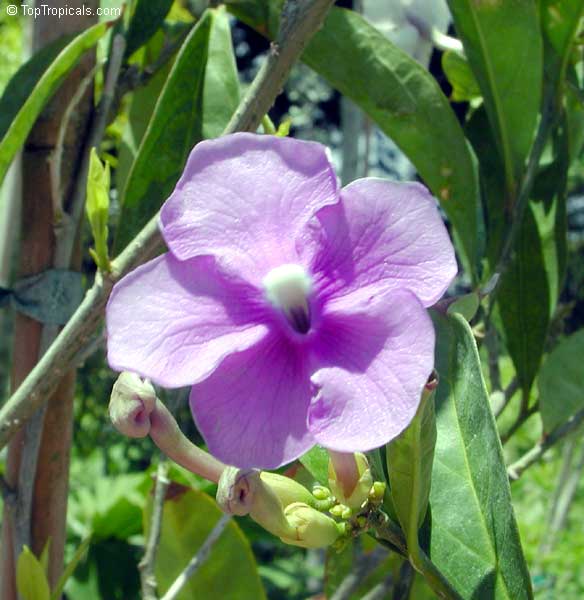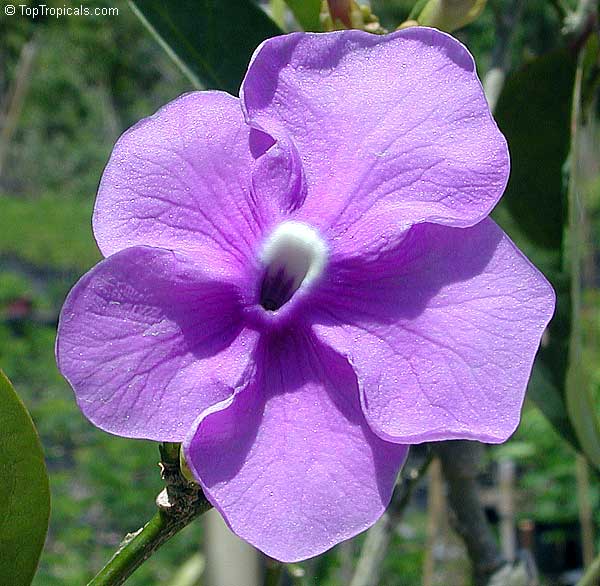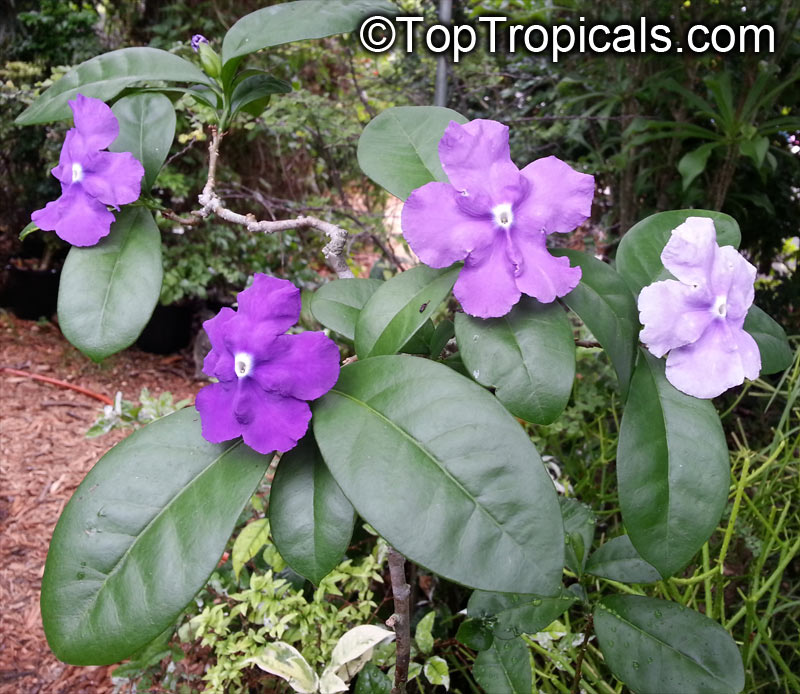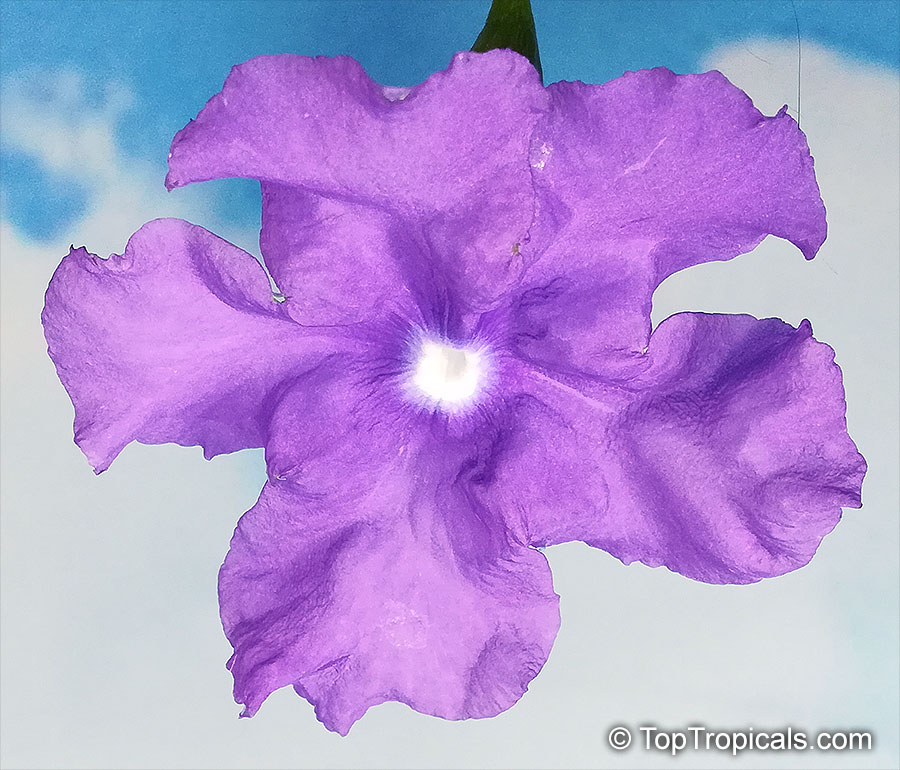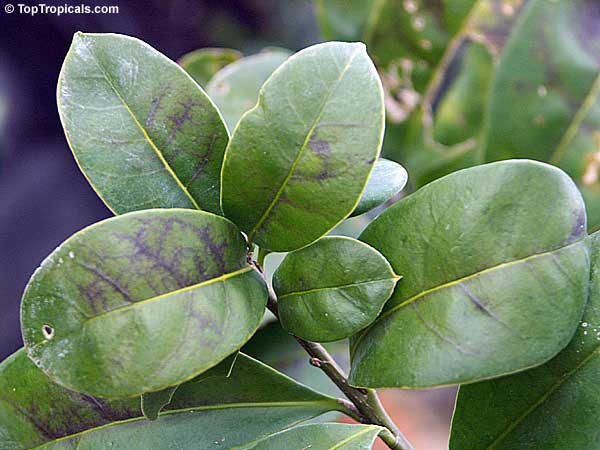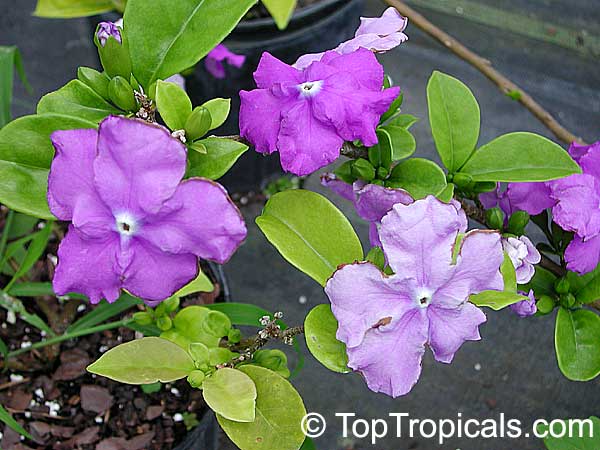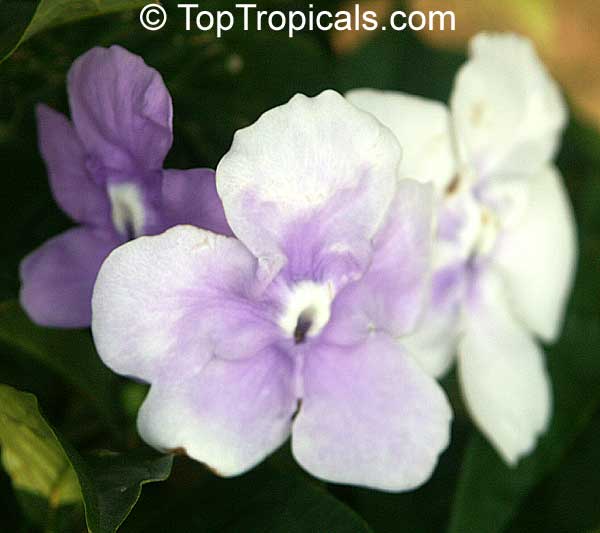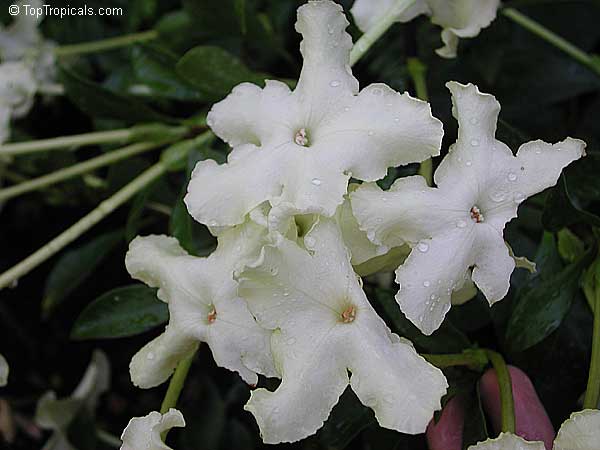Brunfelsia - Plant Encyclopedia Results
Top Tropicals Plant Encyclopedia
| Number of plants found: 15 | Next | 
|
Go to page: | 1 | 2 |
Botanical name: Brunfelsia americana
Common name: Lady of the night
Family: Solanaceae
Origin: Brazil
Hardiness: 30°F









Brunfelsia americana (Lady of the Night), native to Brazil, is a large shrub growing 5-10 ft tall. It prefers full sun to semi-shade, regular watering and well-drained soils. This plant produces creamy white to off-white flowers which are quite fragrant especially at night. They are also attractive to butterflies and hummingbirds.
Brunfelsia americana can be grown in a container in cold regions in USDA Zone 9-11, but is only mature-plant cold hardy down to temperatures in the 30s F for a short time. To ensure that your plant survives during cold weather, make sure it is planted in a large enough container, so that it can be moved indoors in late autumn. When keeping the plant indoors, make sure it is placed in a bright window and watered regularly.
In conclusion, Brunfelsia americana is a beautiful and low-maintenance shrub, perfect for any garden. It's attractive flowers, with their sweet fragrant scent at night, will attract butterflies and hummingbirds to your garden. However, caution should be taken when handling the plant, as all parts of it are highly toxic.
Recommended Fertilizer: SUNSHINE Pikake - Fragrant Flower Booster
Ordering seeds info
RECOMMENDED SUPPLIES:
Seed Germination Mix #3, professional grade
SUNSHINE-Epi - Seeds and cuttings booster
SUNSHINE Bombino - Young Plant Booster
Botanical names: Brunfelsia australis, Brunfelsia bonodora, Brunfelsia latifolia
Common name: Yesterday-Today-and-Tomorrow
Family: Solanaceae
Origin: Argentina, Paraguay, Brazil












The fragrant flowers open purple, fade to lavender, then white. There are 42 known species of Brunfelsia ranging from shrubs to trees. Brunfelsia are in the Solanaceae, the family rich in alkaloids.
See article about Brunfelsias: Yesterday-Today-Tomorrow, Brunfelsia from Brazil.
See article about Brunfelsias: Yesterday-Today-Tomorrow, Brunfelsia from Brazil.
Recommended Fertilizer: SUNSHINE Megaflor - Bloom Nutrition Booster
Botanical name: Brunfelsia densifolia
Common name: Serpentine Hill rain tree
Family: Solanaceae
Origin: Puerto Rico









Brunfelsia densifolia grows in USDA Zone 9-11 and can reach a mature height of 5-10 ft. Once established, it requires very little water and can tolerate periods of drought. When watering, they should be kept on the dry side as they don't appreciate being over-watered. It can survive short periods of cold as low as the 30s F for a short time, making it a very cold hardy plant.
Brunfelsia densifolia has very attractive, fragrant white or off-white flowers that alternate with yellow or orange flowers from year to year. This plant is relatively easy to care for and grows best in full sun to semi-shade. In cold regions, the plant is best grown in a container and brought in over winter to prevent leaf damage from cold. When caring for Brunfelsia densifolia in container, water regularly but maintain a soil that drains well. Feed your serpentine hill rain tree with a balanced fertilizer formula every two months during the growing season and once a year in winter. Prune any damaged branches in the spring, and deadhead spent flowers to encourage new bloom.
Recommended Fertilizer: SUNSHINE Pikake - Fragrant Flower Booster
Botanical name: Brunfelsia gigantea
Common name: Lady of the Night
Family: Solanaceae
Origin: Brazil








Brunfelsia gigantea is a large shrub that grows to about 5-10 feet tall. It is native to Brazil and is known for its beautiful white, off-white flowers and fragrant scent. It attracts butterflies and hummingbirds. Even though this plant looks beautiful, all parts of it should be considered poisonous or toxic to the touch, especially the roots and the fruits.
Brunfelsia gigantea grows best in full sun to semi-shade and requires regular watering for health and growth. In USDA Zones 9-11, this plant does very well in a pot, as it can handle colder regions. To plant a Brunfelsia in a pot, make sure the pot is large enough and has good drainage, then fill it with a good quality soil mix that drains well. Provide enough space between plants, and make sure to water regularly and occasionally fertilize. As they grow, they may need pruning and may develop a leggy look. If this happens, prune the plant to give it a more compact shape, but avoid cutting through the flowering parts of the plant.
Recommended Fertilizer: SUNSHINE Pikake - Fragrant Flower Booster
Botanical name: Brunfelsia grandiflora
Common names: Yesterday -Today -Tomorrow, Kiss-me-quick, Royal Purple Brunfelsia
Family: Solanaceae
Origin: Brazil












The unusual popular name of this medium-sized shrub becomes clear to anyone who observes it over the course of two or three days. Its tubular fragrant flowers change from purple to lavender and then to white over a three day period (First they open as rich lavender blue; then they change to pale lavender and finally to almost white before they fall). Then all three colors can be seen on the same plant.
Brunfelsia grandiflora ( Yesterday-Today-Tomorrow) is a large shrub of the nightshade family, native to Brazil. This particular species is the fast growing, and can reach a height up to 5-10 ft tall, but is a slower growing than many of its relatives. It is an evergreen with glossy green leaves and can display a stunning display of pink, white and off-white flowers in the late autumn and late winter. The flowers are star-shaped, appear in clusters and can fill the garden with a sweet and delicate fragrance. It also attracts hummingbirds, butterflues and other pollinators to its soft petals.
The Brunfelsia grandiflora performs best when grown in USDA Zone 9-11 in the US and requires regular water in most climates. This shrub can tolerate a mature plant's temperature down to at least 30F for a short period of time. It's a great choice for a garden bed or border background and can also be grown in large pots with a rich soil and well-drained soil. In cooler region it best grown in pots near the entrance or close to a window, as it can easily adapts to partial shade or semi-shade environment.
Brunfelsia grandiflora is a drought tolerant plant and requires minimal care. It can do well with regular watering and occasional fertilizing, as well as removal of faded flowers and leaves. With enough sun and moisture it will certainly be able to thrive and become a great addition to any garden.
All parts of a plant are toxic, especially roots and fruits, to a lesser degree leaves.
See article about Brunfelsias: Yesterday-Today-Tomorrow, Brunfelsia from Brazil.
Recommended Fertilizer: SUNSHINE Megaflor - Bloom Nutrition Booster
Botanical names: Brunfelsia jamaicensis, Brunfelsia plicata
Common name: Lady of the Night
Family: Solanaceae
Origin: Jamaica










Brunfelsia plicata is a fast-growing, small, erect, delightfully fragrant flowering shrub endemic to Jamaica. The sturdy, dark green leaves make a good background for the showy, white flowers. The creamy white flowers with long tubes are extremely fragrant after dark. In some places it is known as Lady of the Night, though a number of other scented plants have also been given this name. Blooms fall to winter. It
Recommended Fertilizer: SUNSHINE Pikake - Fragrant Flower Booster
Botanical name: Brunfelsia lactea
Common name: Lady of the night
Family: Solanaceae
Origin: Puerto Rico








Brunfelsia lactea, commonly known as the Lady of the Night, is a large shrub hailing from the tropical regions of Puerto Rico. It grows up to 10 feet in height, forming an upright structure with a rounded shape. Its small, oval-shaped leaves are deep green in color, giving this shrub an attractive, bushy appearance.
The most striking feature of the Lady of the Night is its flowers. They bloom in clusters of 3 to 6, and range in color from off-white to white, each flower measuring an inch or two in length. What makes this plant so special is that the flowers are deeply fragrant, especially at night, and attract butterflies and hummingbirds.
In terms of care, the Lady of the Night grows best when planted in semi-shade and watered regularly, but it doesn't need too much attention. It can be grown in USDA Zones 9-11. When growing in a pot in cold regions, take extra care to protect the plant during winter and the temperature should not fall below 30°F.
The Lady of the Night is toxic, so children and pets should be kept away from it.
Botanical name: Brunfelsia magnifica var. floribunda
Common names: Morning, Noon and Night
Cultivar: Floribunda
Family: Solanaceae
Origin: Brazil









Brunfelsia magnifica Floribunda, or Morning, Noon and Night, is a large ever-blooming shrub native to Brazil. THe most fragrant Brunfelsia with large fragrant flowers. They are two inches in diameter, tubular with five petals. Common name comes from the three colors of the flowers. They begin a dark purple, fade to lavender, then to white. This rare variety of purple Brunfelsia is an attractive addition to any garden and is tolerant of a variety of climates and soils. Its USDA hardiness zone is 9-11 and if grown in colder areas with temperatures below 32F, additional protection from freezing is necessary.
In cold areas container-grown plants should be placed in a sheltered area and mulched for additional insulation - it may also be helpful to prune the plant to keep the foliage to a minimum. For all areas, to ensure your plant stays healthy, water regularly and fertilize twice a year. A good quality fertilizer is recommended, and the plant should be repotted every two years.
This plant is very slow growing and hard to propagate. Rare, high demand.
Recommended Fertilizer: SUNSHINE Pikake - Fragrant Flower Booster
Botanical name: Brunfelsia mire
Common name: Brunfelsia
Family: Solanaceae
Origin: Peru





The genus Brunfelsia belongs to the alkaloid-rich family Solanaceae and usually is placed in the relatively advanced tribe Salpiglossideae. Brunfelsia is a medium-sized genus of about 42 species of small trees and shrubs: 22 species are confined to the West Indies; 20 species are found in tropical South America. B. Mire and the related B. hydrangeiformis cause paralysis and stimulation of the
Botanical name: Brunfelsia nitida
Common name: Lady of the Night
Family: Solanaceae
Origin: Puerto Rico and Cuba








Because of the fragrance, this plant is nice to plant near a patio or pool. Performing exceptionally well in containers, this species creates a dazzling display of long tubular blossoms from late spring through fall. Flowers emerge pure white and age to cream emitting a spicy fragrance in the evening. Fruit is a small round capsule containing many seeds. Prefers filtered light. All parts of a plant are toxic, especially roots and fruits, to a lesser degree leaves.
See article about Brunfelsias: Yesterday-Today-Tomorrow, Brunfelsia from Brazil.
Recommended Fertilizer: SUNSHINE Pikake - Fragrant Flower Booster
Ordering seeds info
RECOMMENDED SUPPLIES:
Seed Germination Mix #3, professional grade
SUNSHINE-Epi - Seeds and cuttings booster
SUNSHINE Bombino - Young Plant Booster
| Next |  |
Use link to repeat this search:
https://toptropicals.com/cgi-bin/garden_catalog/cat.cgi?find=Brunfelsia&search_op=and&keyword_op=and&language=e&number=10
&no_change_lang=1&user=tt&sale=1&first=0
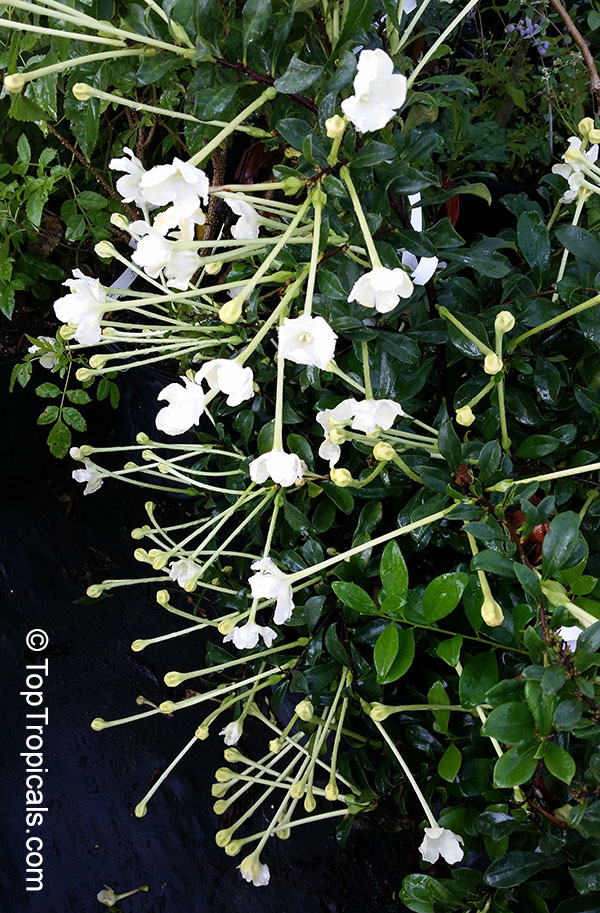

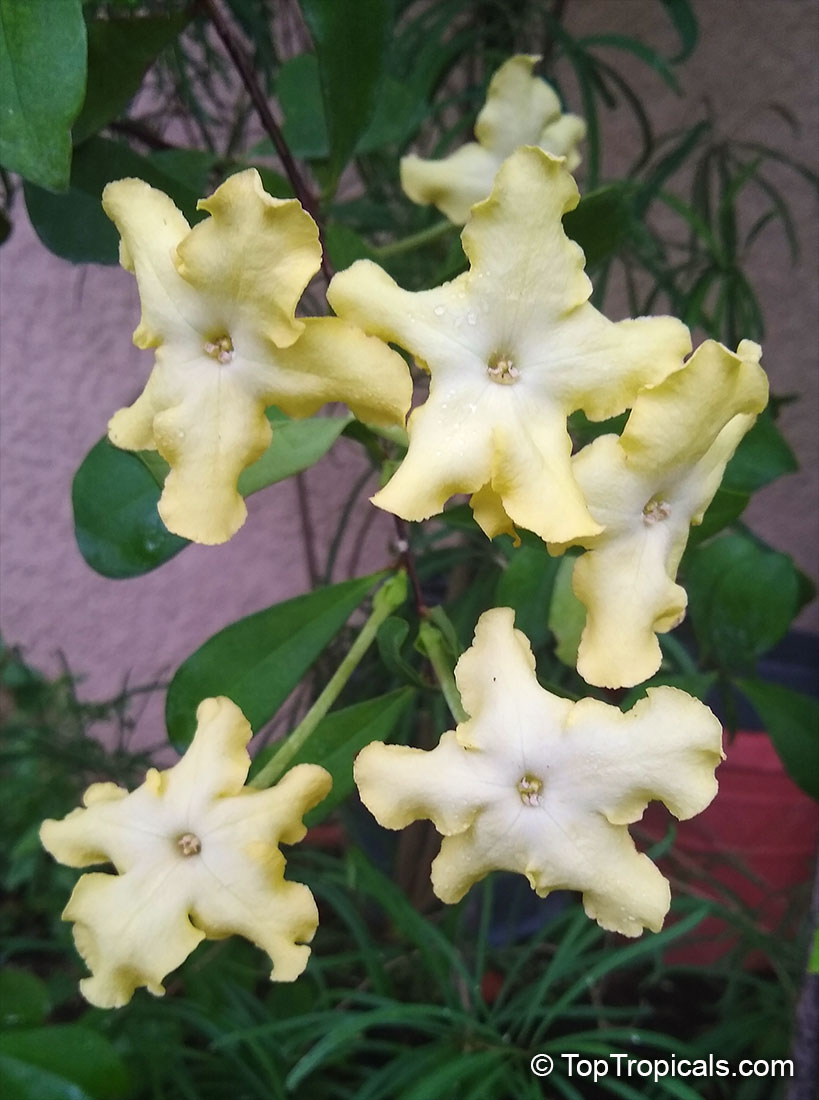
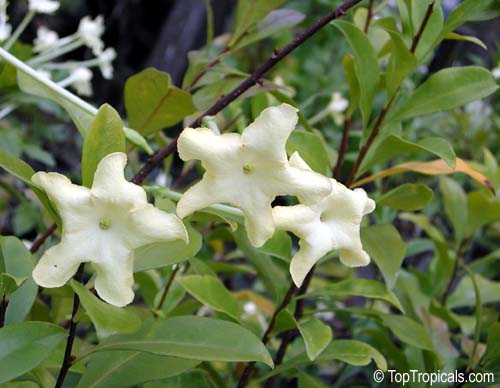
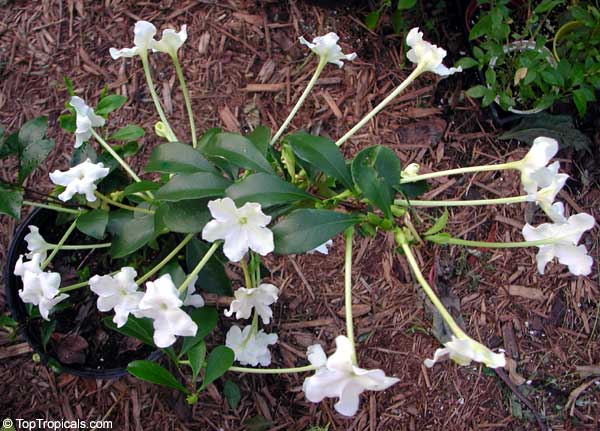
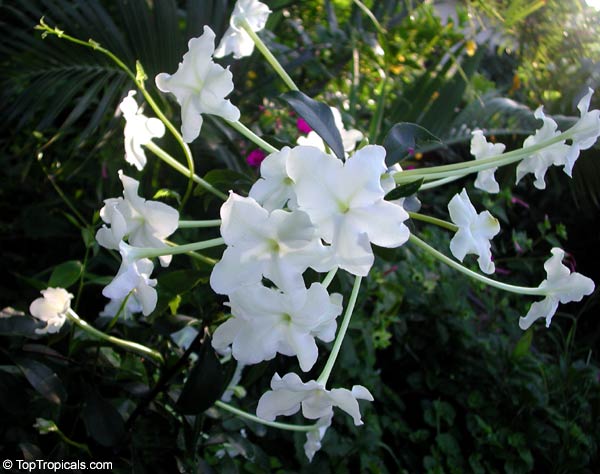
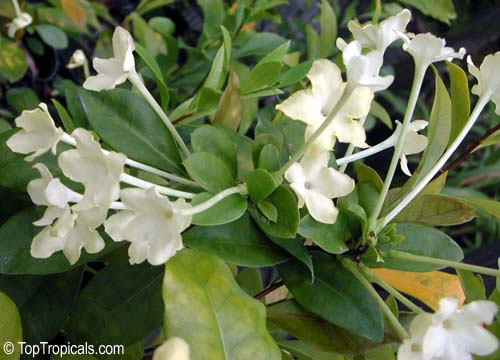
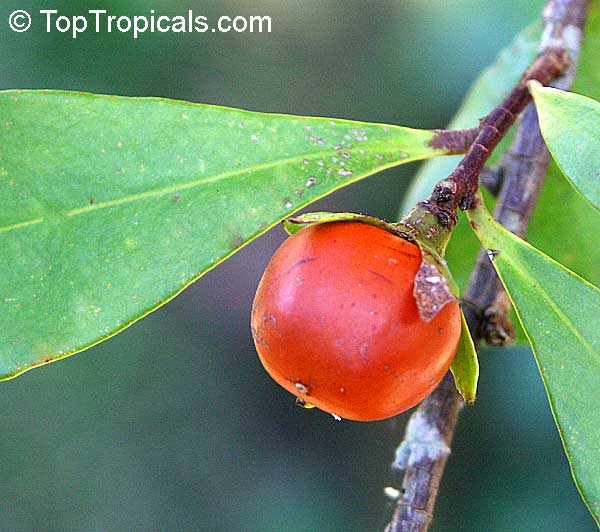
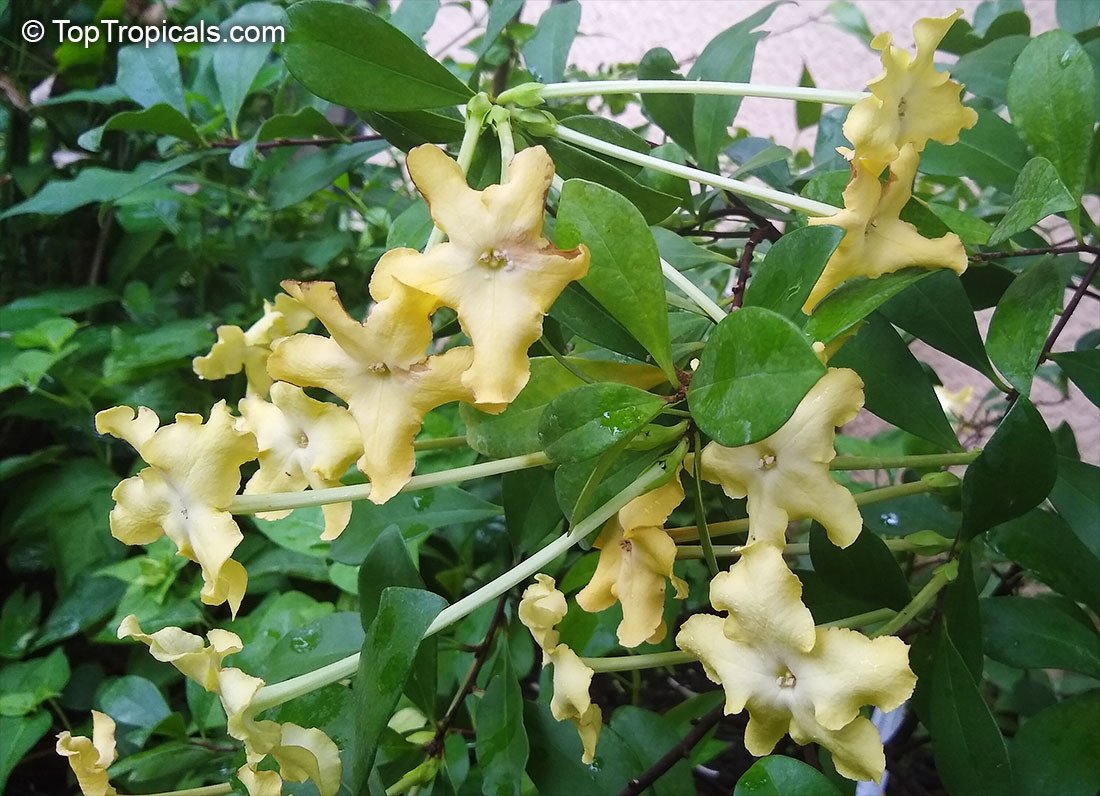
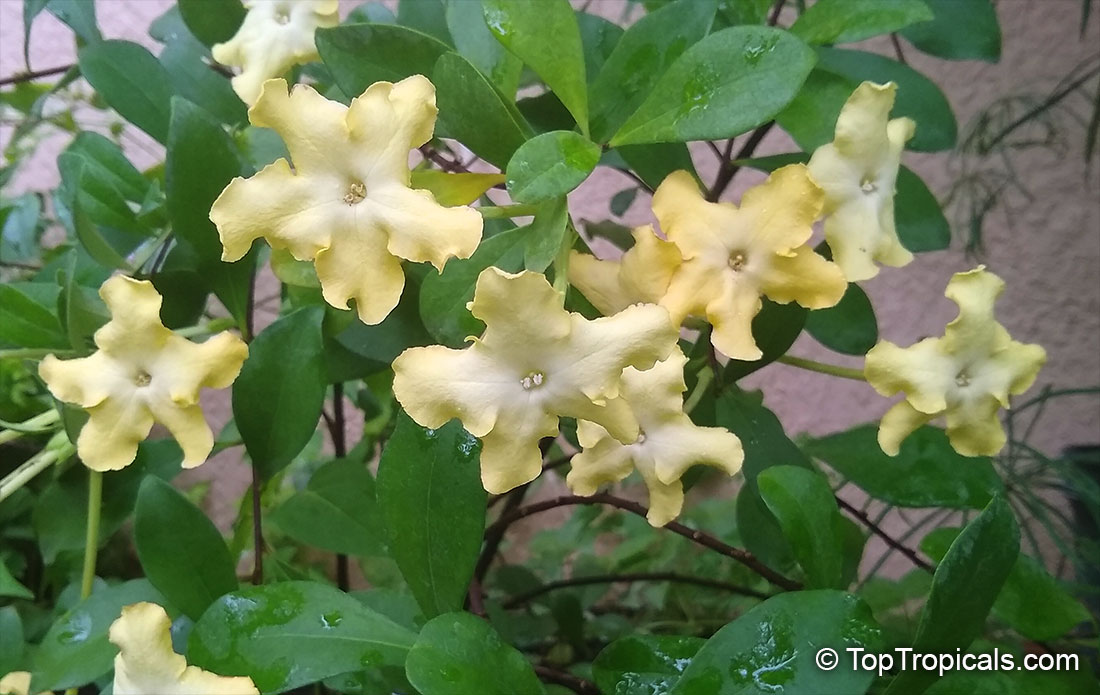
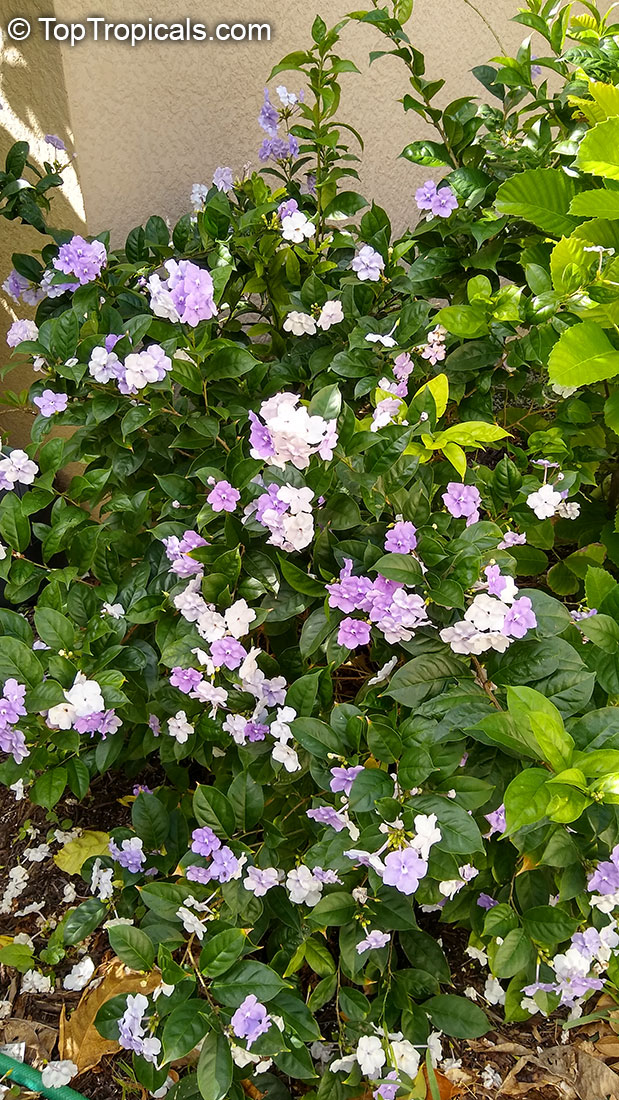

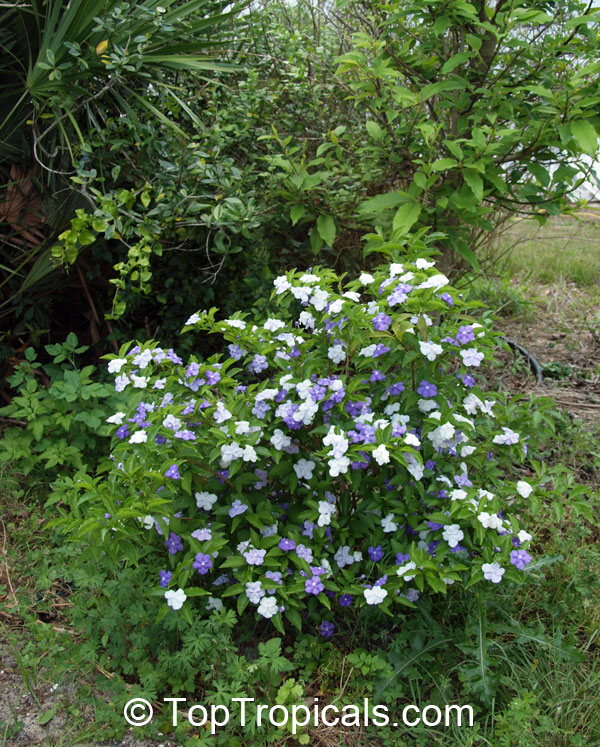
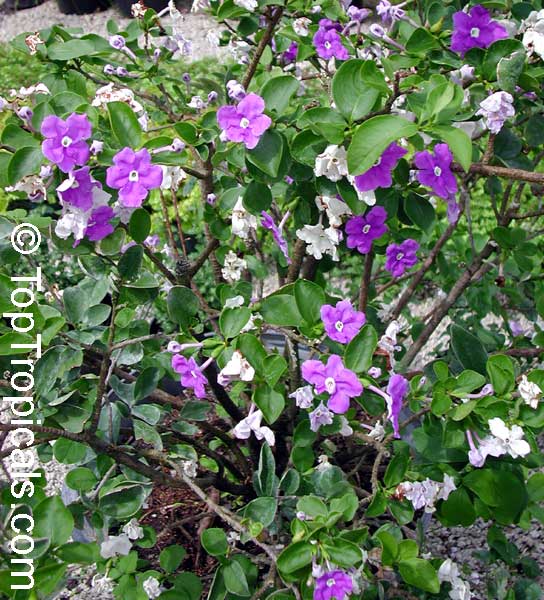
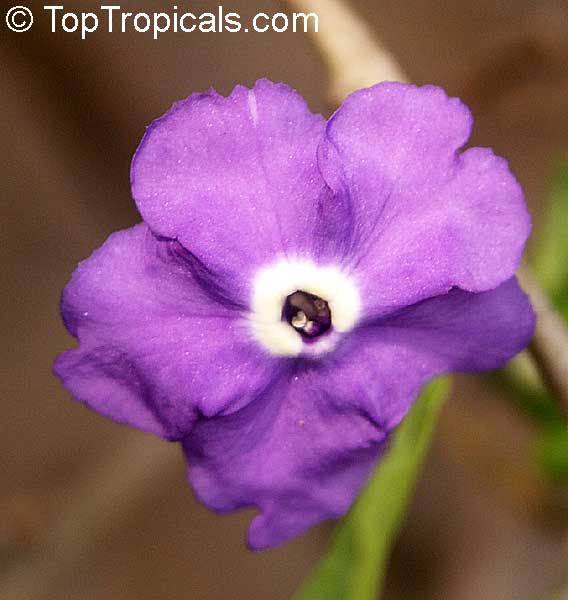
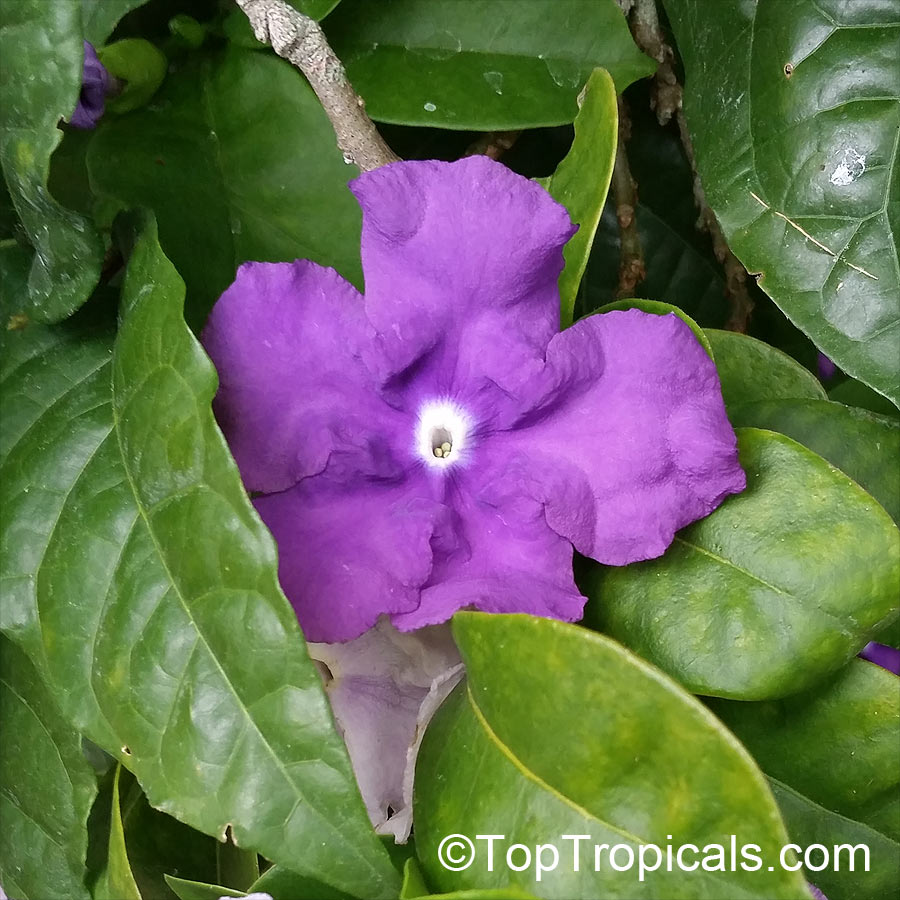

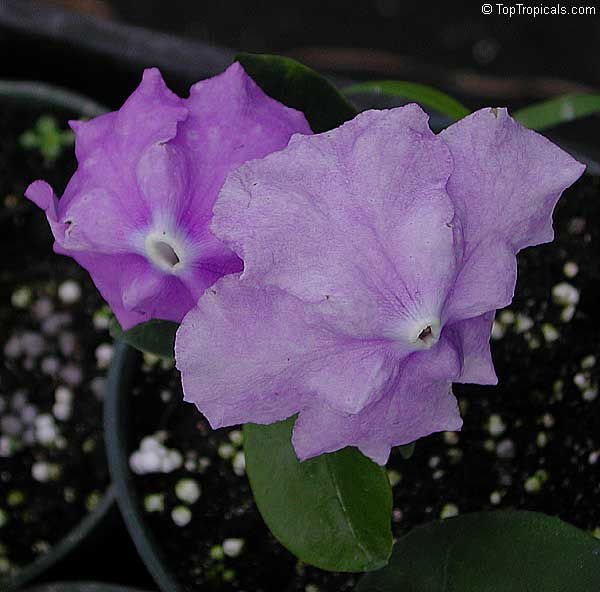
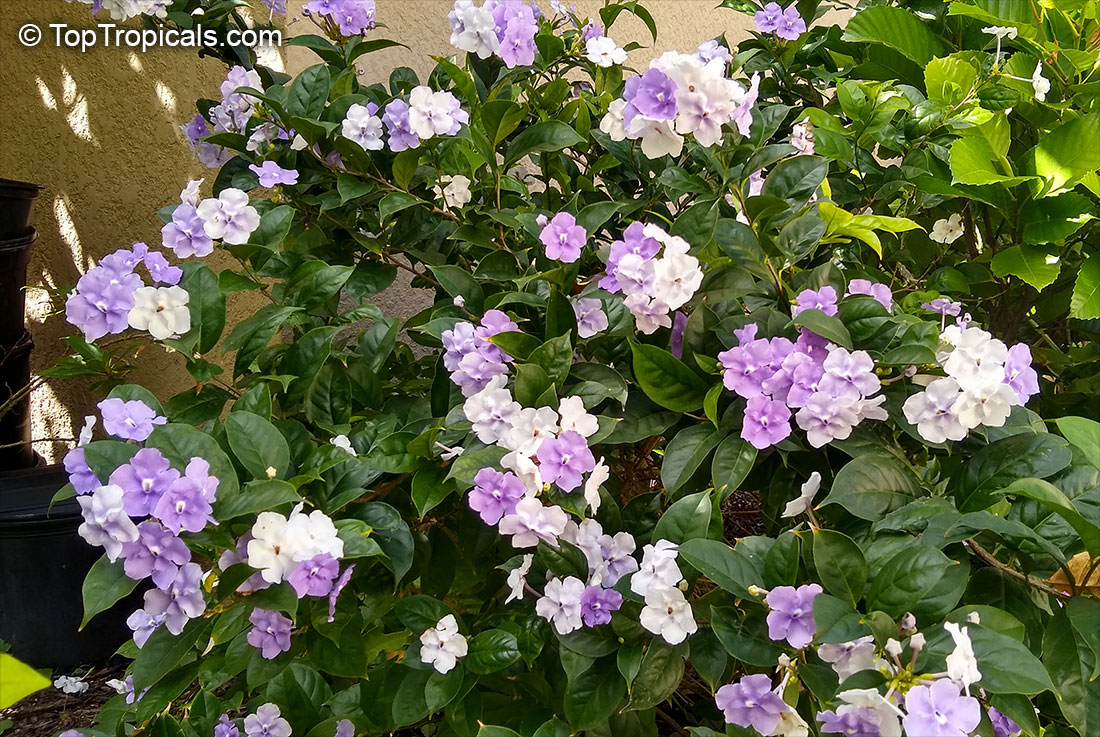
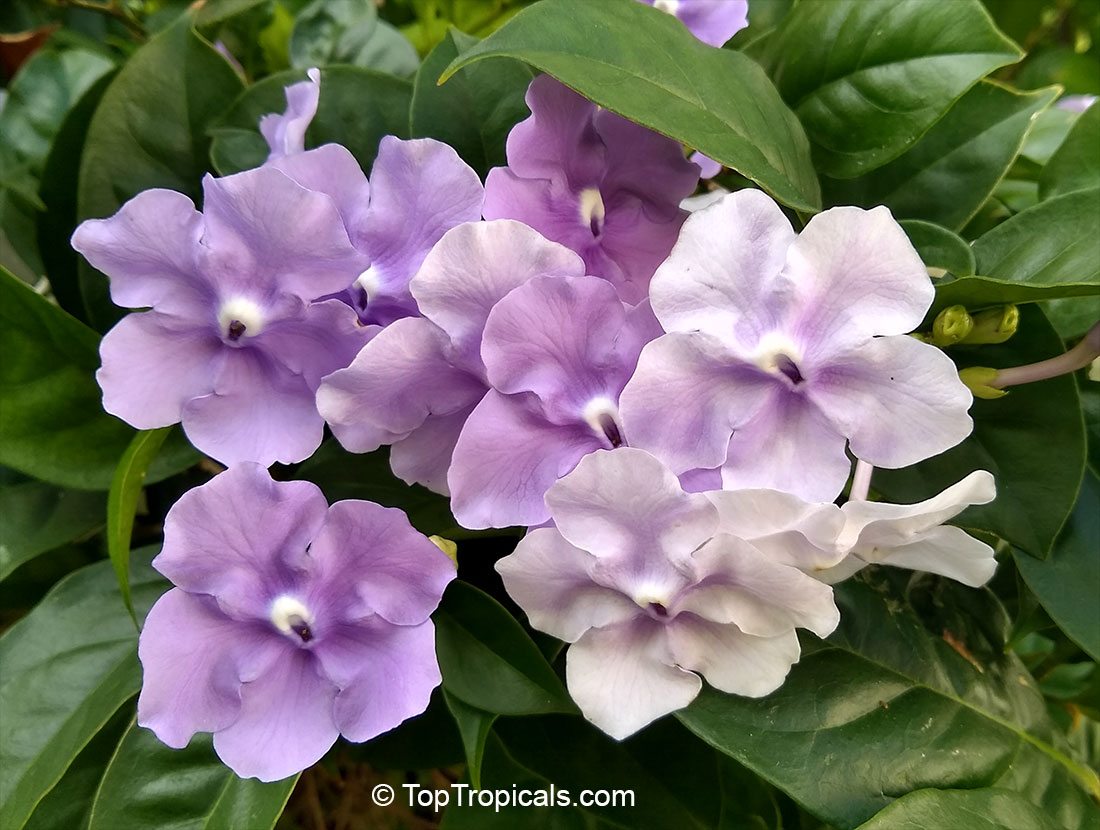
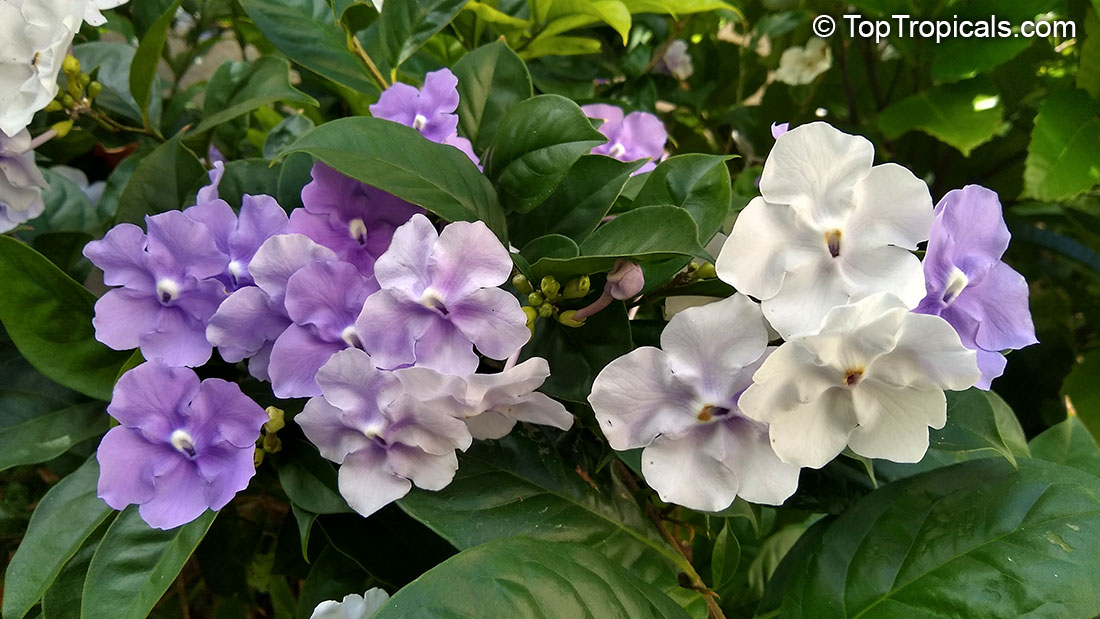
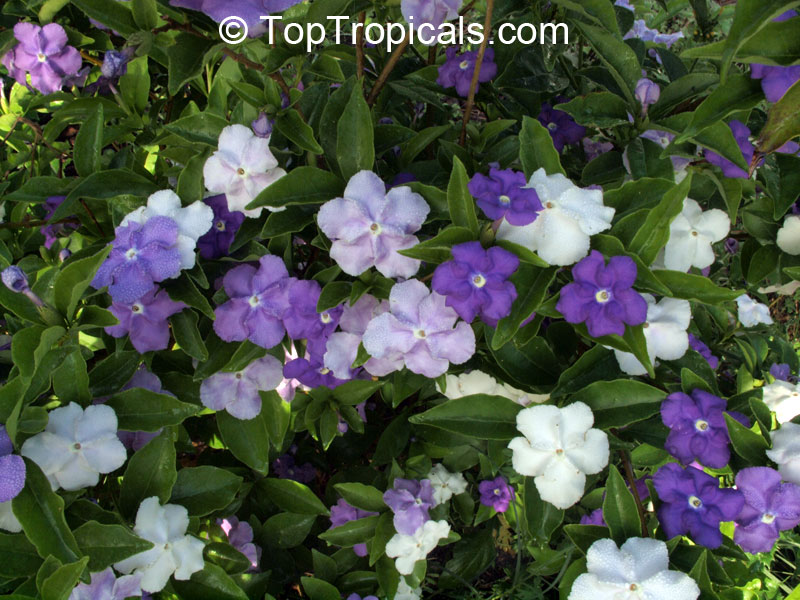

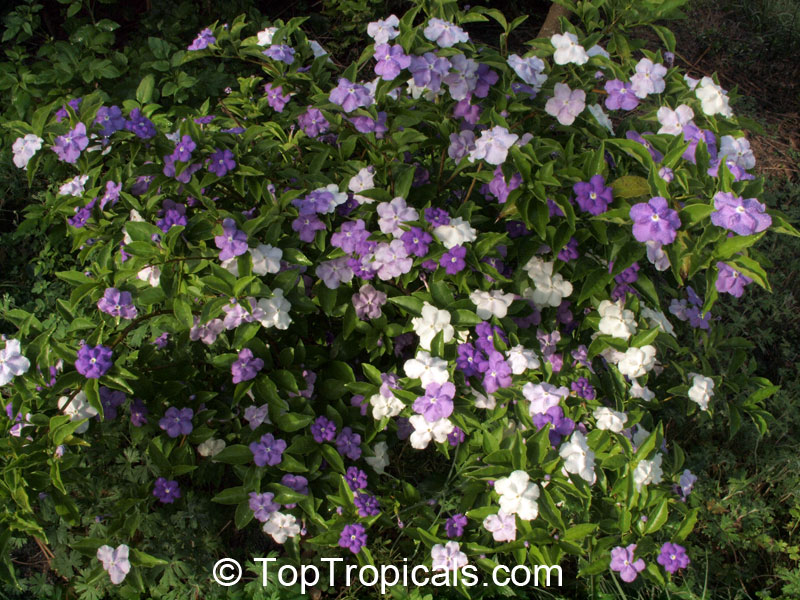
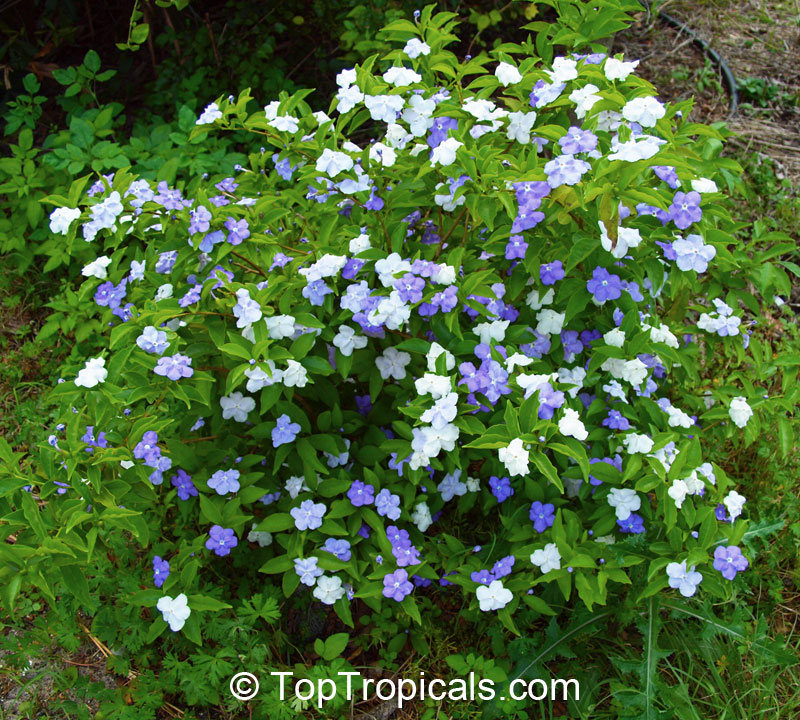
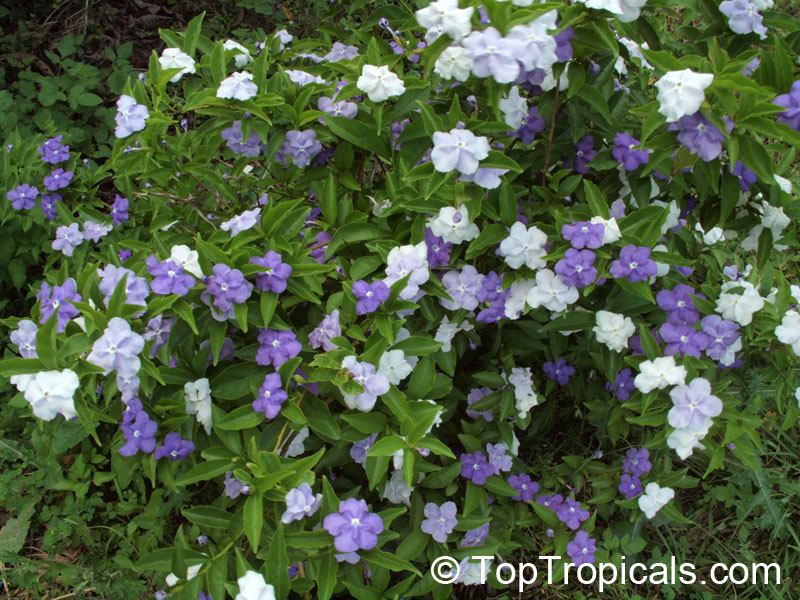
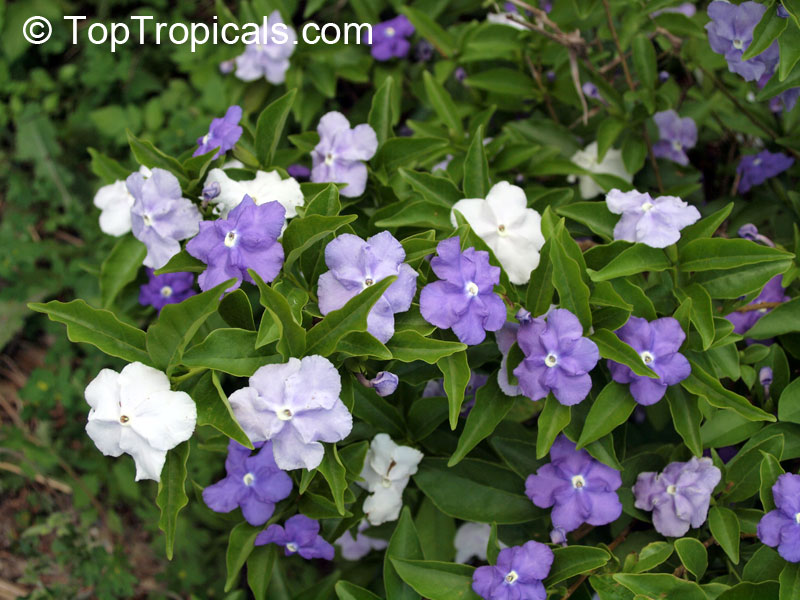
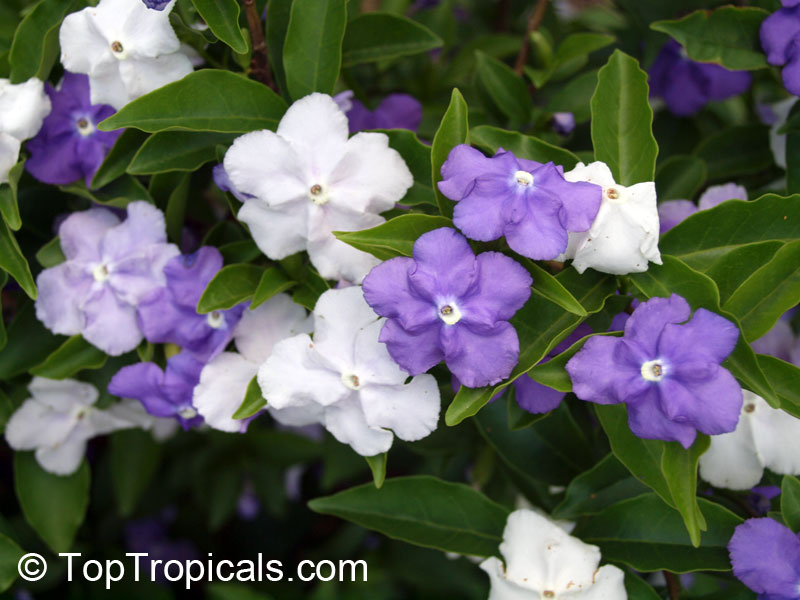
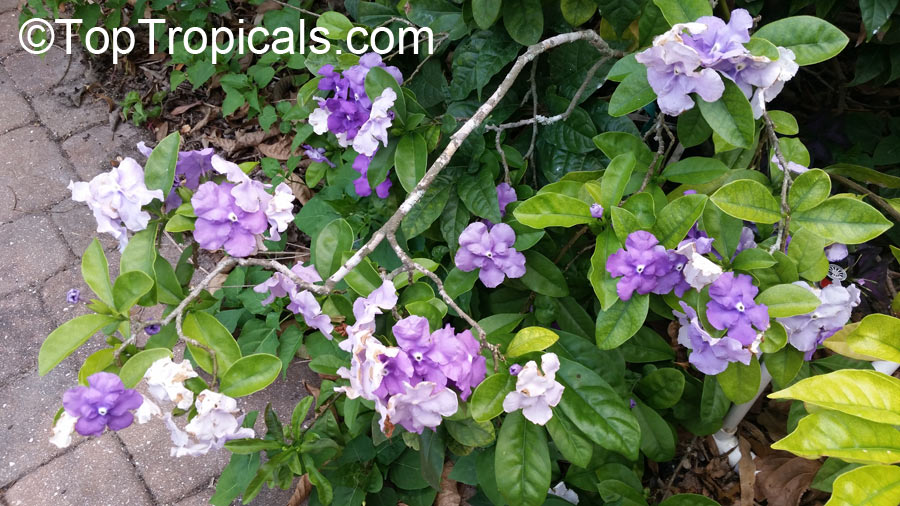
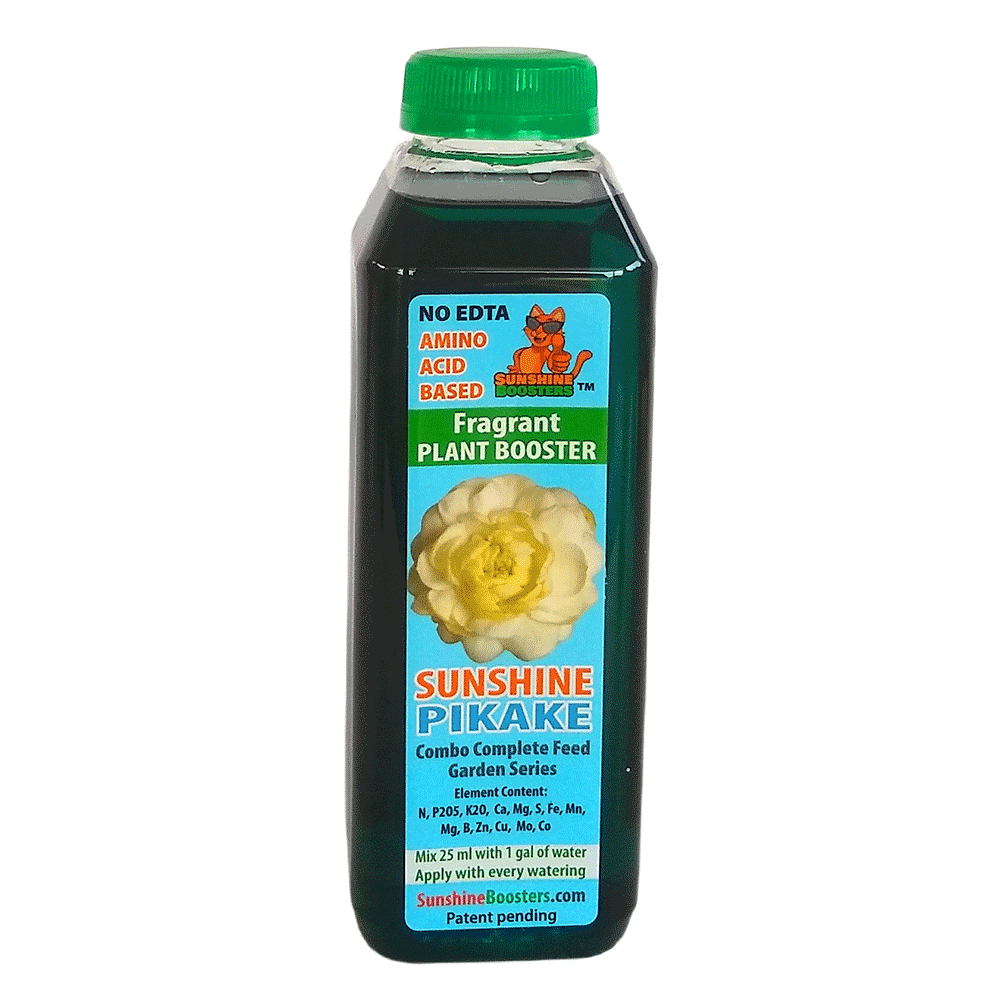 SUNSHINE Pikake (NPK 2-2-4) - eco-friendly concentrated nutrition booster for fragrant flowers. Improves quantity and quality of flowers. Encourages profuse blooming. Increases flower fragrance intensity. Can be used with every watering. For best results, use in combination with
SUNSHINE Pikake (NPK 2-2-4) - eco-friendly concentrated nutrition booster for fragrant flowers. Improves quantity and quality of flowers. Encourages profuse blooming. Increases flower fragrance intensity. Can be used with every watering. For best results, use in combination with 